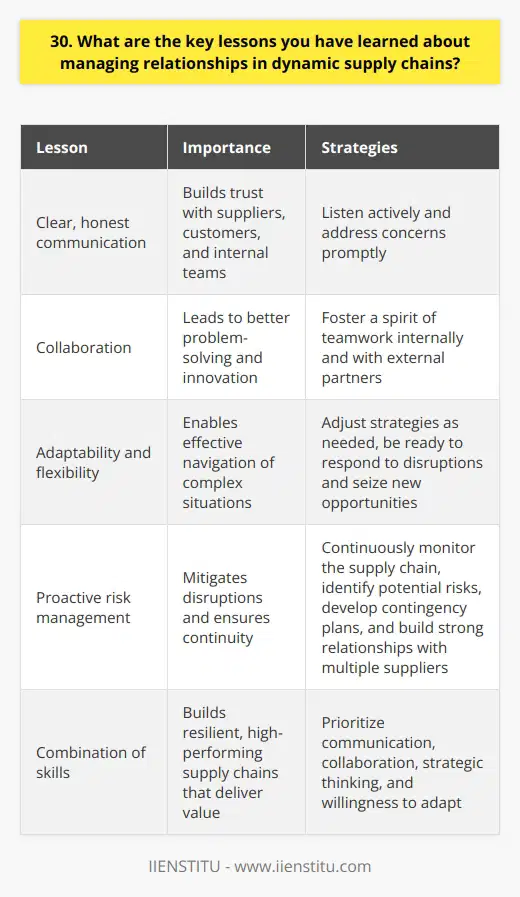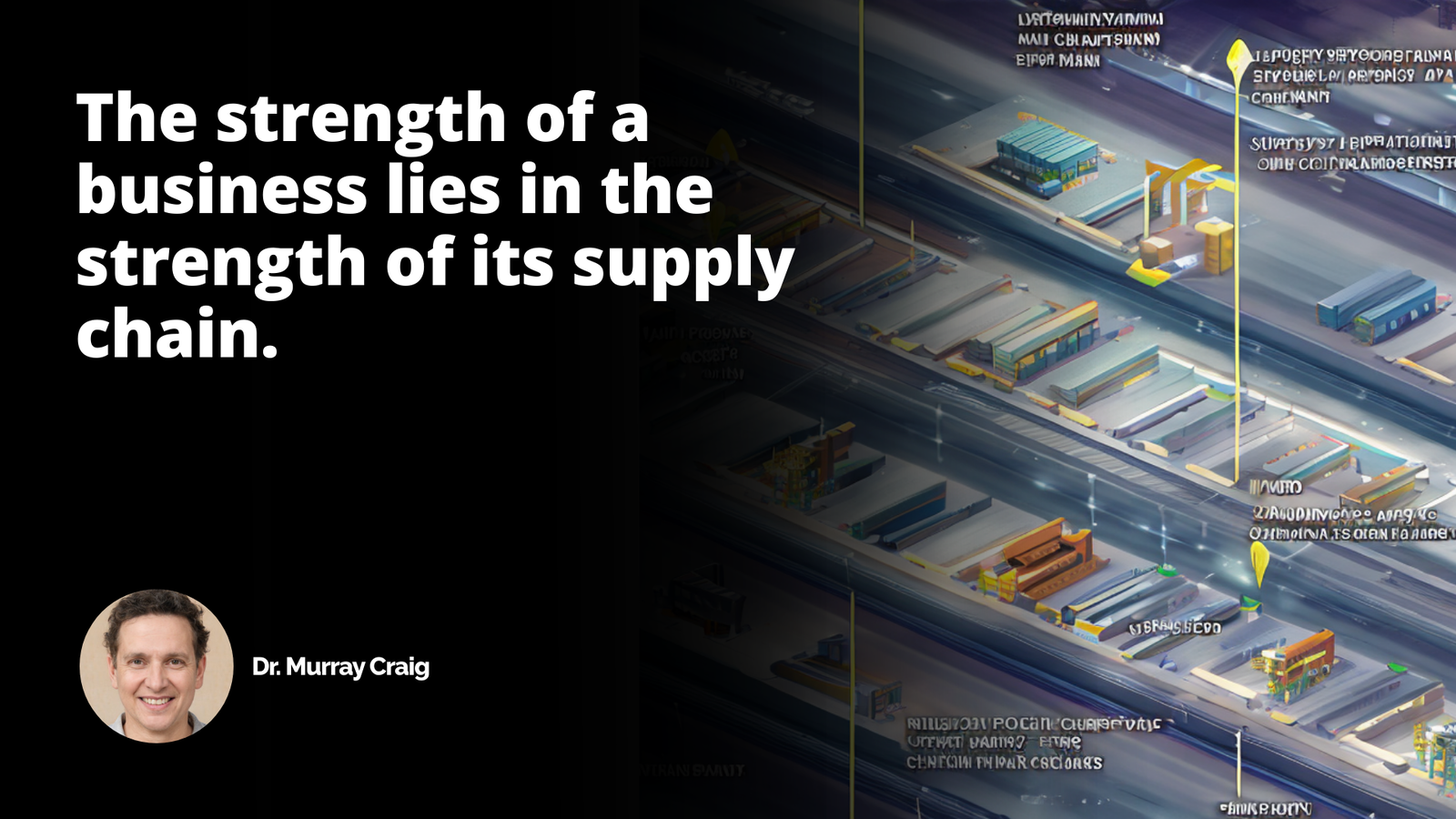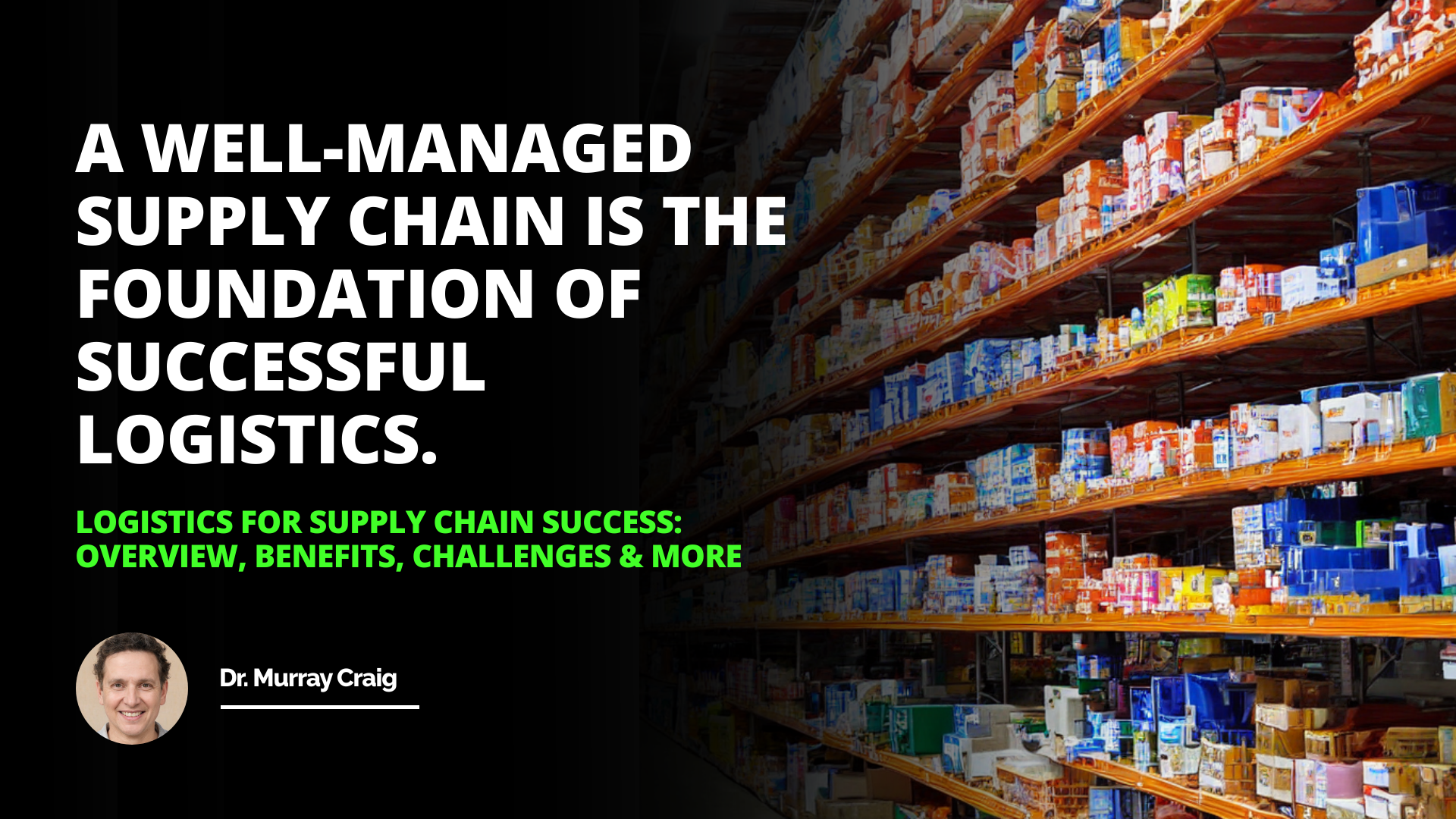
In the ever-evolving landscape of supply chain management, the importance of maintaining strong, dynamic relationships cannot be overstated. As someone who has been in the trenches of this field for years, I can attest to the fact that the success of a supply chain hinges on the strength of its relationships. It's not just about moving goods from point A to point B; it's about fostering a network of trust, communication, and collaboration that can weather any storm.
When I first started out in this industry, I was fresh out of college and eager to make my mark. I had a head full of theories and a heart full of ambition. But as I soon discovered, the reality of supply chain management was far more complex than I had anticipated. It wasn't just about crunching numbers and optimizing routes; it was about navigating the delicate web of human relationships that held everything together.
I remember one particular incident that drove this point home for me. We were working with a new supplier, and everything seemed to be going smoothly. Orders were being filled, deadlines were being met, and everyone was happy. But then, out of nowhere, we hit a snag. The supplier was experiencing some internal issues, and they were struggling to keep up with our demands.
Interview Question How Often Do You Use Problem Solving İn Job İnterviews
How To Answer How Do You Manage Tight Deadlines İn Job İnterviews
At first, I was frustrated. We had a business to run, and we couldn't afford any delays. But then I took a step back and realized that this wasn't just a logistical problem; it was a human one. These were real people on the other end of the line, with real challenges and real emotions. So instead of getting angry or issuing ultimatums, I picked up the phone and had a conversation.
Logistics Management Job Interview: Key Questions to Prepare For
Interview Question: How Do You Define Successful Time Management?
Interview Question: Any Experience with Global Digital Marketing?
It turned out that the supplier was going through a tough time. They were dealing with some staff turnover and some equipment malfunctions, and they were feeling overwhelmed. By taking the time to listen and understand their perspective, we were able to come up with a solution that worked for everyone. We adjusted our timelines, offered some technical support, and even sent over some of our own staff to help out. In the end, not only did we get our orders filled, but we also strengthened our relationship with that supplier. They knew that we had their back, and that we were invested in their success as much as our own.
Long Tail Keyword For S&op Success İn Supply Chain Management
How Time Management Strategies Have Evolved For Job İnterview
Strategies To Optimize Supply Chain Management For Maximum Efficiency
This experience taught me a valuable lesson about the importance of communication in supply chain partnerships. It's not enough to just place orders and expect them to be fulfilled; you have to be willing to have honest, open conversations with your suppliers. You have to be able to listen to their concerns, understand their challenges, and work together to find solutions. This is especially true in today's fast-paced, ever-changing business environment, where supply chains are more complex and interconnected than ever before.
"In my previous role in the supply chain departments, I prioritized building strong relationships with our vendors. By implementing a vendor management inventory system, we improved transparency and trust. This approach not only streamlined our processes but also enhanced our partnerships."
Another key aspect of maintaining relationships in dynamic supply chains is building trust. Trust is the foundation upon which all successful partnerships are built. Without trust, there can be no true collaboration, no shared sense of purpose, and no long-term success. But building trust takes time and effort. It requires consistency, reliability, and a willingness to go above and beyond.
One way to build trust with suppliers is through transparency. Be open and honest about your needs, your expectations, and your challenges. Share information freely, and don't be afraid to admit when you've made a mistake or need help. By creating an environment of openness and honesty, you'll foster a sense of trust and mutual respect that will serve you well in the long run.
How can one maintain relationships in dynamic supply chains?
What strategies exist for maintaining successful relationships in a dynamic supply chain?
How important is relationship maintenance in a dynamic supply chain?
What techniques are beneficial when working to maintain relationships within a dynamic supply chain?
What challenges could one encounter when trying to maintain relationships in dynamic supply chains?
Why is it significant to maintain relationships in dynamic supply chains?
What are the consequences of not maintaining relationships in a dynamic supply chain?
Can dynamic supply chains function optimally without maintaining relationships?
Who holds primary responsibility for relationship maintenance in dynamic supply chains?
How does maintaining relationships in dynamic supply chains impact overall business performance?
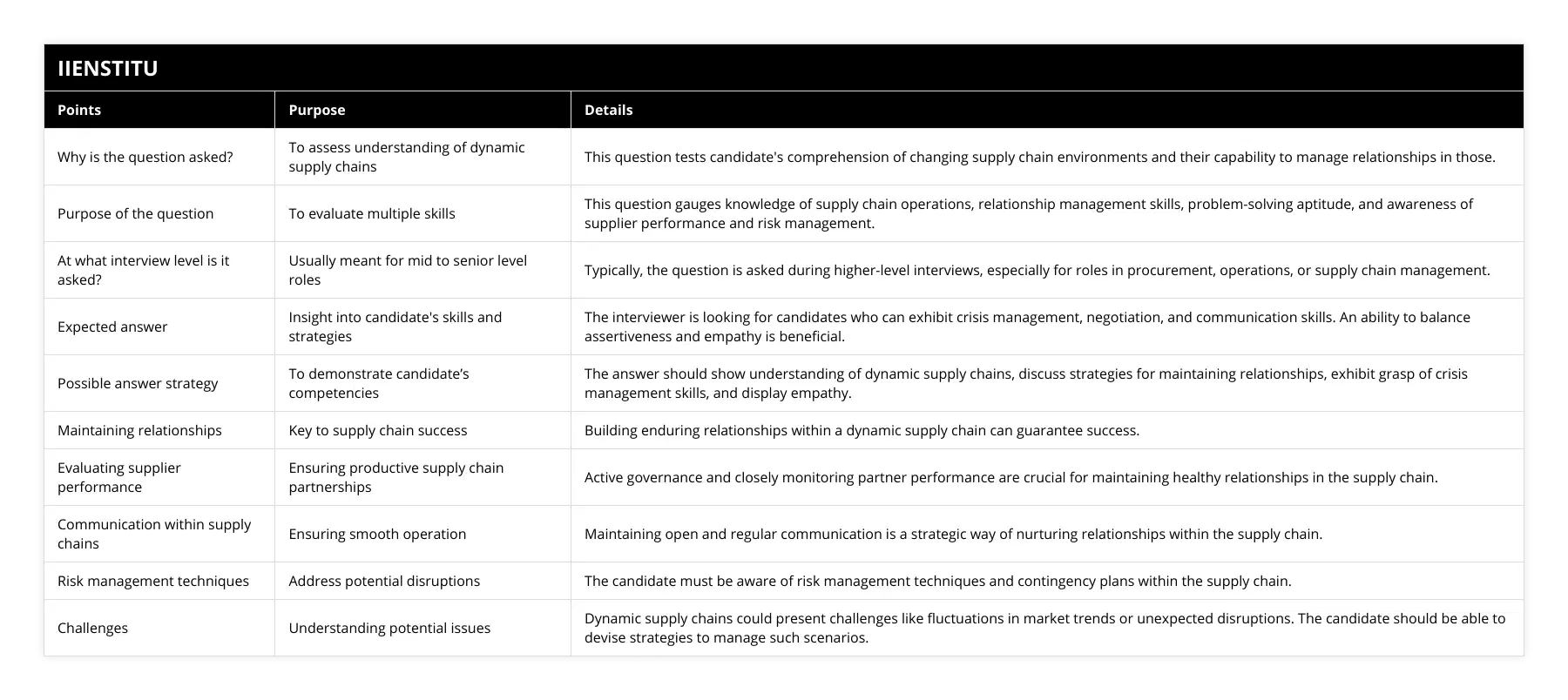
Another important factor in building trust is reliability. When you make a promise, keep it. When you commit to a deadline, meet it. When you say you'll do something, follow through. This may seem like common sense, but in the fast-paced world of supply chain management, it's all too easy to let things slip through the cracks. By consistently delivering on your promises, you'll earn the trust and respect of your suppliers, and you'll be able to weather any storms that come your way.
Of course, building and maintaining relationships in dynamic supply chains is not without its challenges. One of the biggest challenges is dealing with cultural differences. In today's global economy, supply chains often span multiple countries and cultures, each with its own unique customs, values, and ways of doing business. Navigating these differences can be tricky, and it requires a high degree of cultural intelligence and adaptability.
One way to overcome cultural barriers is through education and training. Take the time to learn about the cultures and customs of your suppliers, and provide training for your own staff on how to communicate and collaborate effectively across cultural boundaries. This may involve learning new languages, adopting new communication styles, or even traveling to supplier locations to build personal relationships.
Another challenge in maintaining relationships in dynamic supply chains is dealing with supply chain disruptions. In today's fast-paced, interconnected world, disruptions can come from anywhere at any time. A natural disaster, a political upheaval, or even a sudden shift in consumer demand can all throw a wrench into even the best-laid supply chain plans.
The key to overcoming supply chain disruptions is flexibility and adaptability. You need to be able to pivot quickly when the unexpected happens, and you need to have contingency plans in place to mitigate the impact of disruptions. This may involve diversifying your supplier base, building up inventory buffers, or even completely redesigning your supply chain to be more resilient and agile.
But perhaps the most important factor in overcoming supply chain disruptions is collaboration. When disruptions happen, it's essential to work closely with your suppliers to find solutions and minimize the impact on your business. This may involve sharing information, pooling resources, or even temporarily shifting production to alternative locations. By working together in a spirit of collaboration and mutual support, you can weather any storm and come out stronger on the other side.
Of course, collaboration is not always easy, especially in a dynamic and competitive business environment. There may be times when you and your suppliers have conflicting interests or competing priorities. This is where negotiation skills become essential. As a supply chain professional, you need to be able to find common ground, build consensus, and create win-win solutions that benefit everyone involved.
One effective negotiation strategy is to focus on interests rather than positions. Instead of getting locked into a particular stance or demand, try to understand the underlying needs and concerns of your supplier. What are they really looking for? What are their priorities and constraints? By focusing on interests rather than positions, you can often find creative solutions that satisfy everyone's needs.
Another key negotiation skill is active listening. Too often, we enter negotiations with our own agenda and our own ideas, without really taking the time to listen to the other party. But by actively listening to your suppliers, you can gain valuable insights into their perspective and their needs. You can ask questions, clarify misunderstandings, and build a shared understanding of the issues at hand.
Of course, even with the best negotiation skills, there may be times when you and your suppliers simply cannot agree. This is where conflict resolution becomes essential. As a supply chain professional, you need to be able to manage conflicts in a constructive and productive way, without damaging your relationships or your reputation.
One effective conflict resolution strategy is to focus on the problem, not the person. Instead of getting caught up in personal attacks or blame games, try to stay focused on the issue at hand. What is the root cause of the conflict? What are the potential solutions? By staying objective and solution-oriented, you can often find a way forward that works for everyone.
Another important aspect of conflict resolution is empathy. Try to put yourself in your supplier's shoes and understand their perspective. What are their constraints and challenges? What are their hopes and fears? By showing empathy and understanding, you can often diffuse tension and build a more collaborative and productive relationship.
Ultimately, the key to maintaining relationships in dynamic supply chains is to approach them with a spirit of partnership and collaboration. Your suppliers are not just vendors or contractors; they are essential partners in your business success. By treating them with respect, empathy, and understanding, you can build strong, resilient relationships that can weather any storm.
Of course, building and maintaining these relationships takes time, effort, and resources. It may require investing in new technologies, processes, or personnel to support effective communication and collaboration. It may require rethinking your supply chain strategy to prioritize resilience, agility, and adaptability. And it may require a fundamental shift in mindset, from a transactional to a relational approach to supply chain management.
But the payoff is well worth the investment. By building strong, dynamic relationships with your suppliers, you can create a supply chain that is more efficient, more effective, and more resilient. You can reduce costs, improve quality, and enhance customer satisfaction. And you can position your business for long-term success in an ever-changing and unpredictable world.
As I look back on my own journey in supply chain management, I am struck by how much I have learned about the power of relationships. From that early experience with a struggling supplier to countless other challenges and opportunities along the way, I have come to appreciate the vital role that communication, trust, and collaboration play in the success of any supply chain.
And I have also come to realize that these relationships are not just a means to an end, but an end in themselves. The relationships we build with our suppliers, our colleagues, and our customers are what give meaning and purpose to our work. They are what make us human, and what make our businesses truly thrive.
So if you are a supply chain professional looking to succeed in today's dynamic and challenging environment, my advice is simple: focus on the relationships. Invest in communication, build trust, and collaborate with your partners. And never forget that behind every purchase order, every shipment, and every transaction, there are real people with real hopes, dreams, and challenges.
By putting relationships at the center of your supply chain strategy, you can not only optimize your operations and improve your bottom line, but also make a real difference in the lives of the people you work with and the communities you serve. And that, in the end, is what truly matters.
References:
1- Christopher, M. (2011). Logistics and Supply Chain Management (4th ed.). Financial Times Prentice Hall.
2- Lambert, D. M., & Enz, M. G. (2017). Issues in Supply Chain Management: A Capabilities-Based Perspective. Journal of Supply Chain Management, 53(1), 3-13.
3- Mentzer, J. T., DeWitt, W., Keebler, J. S., Min, S., Nix, N. W., Smith, C. D., & Zacharia, Z. G. (2001). Defining Supply Chain Management. Journal of Business Logistics, 22(2), 1-25.
4- Monczka, R. M., Handfield, R. B., Giunipero, L. C., & Patterson, J. L. (2015). Purchasing and Supply Chain Management (6th ed.). Cengage Learning.
5- Simchi-Levi, D., Kaminsky, P., & Simchi-Levi, E. (2008). Designing and Managing the Supply Chain: Concepts, Strategies, and Case Studies (3rd ed.). McGraw-Hill/Irwin.
Frequently Asked Questions
1. How do you foster trust and collaboration among supply chain partners?
I believe that fostering trust and collaboration among supply chain partners is crucial for success. In my experience, open and transparent communication is key to building strong relationships. I make it a point to regularly share information and updates with our partners.
Setting Clear Expectations
Another important aspect is setting clear expectations from the beginning. I work with our partners to establish shared goals and metrics for success. This helps ensure that everyone is on the same page and working towards the same objectives.
Building Personal Connections
I've also found that building personal connections can go a long way in fostering trust. I try to meet with our partners face-to-face whenever possible, even if it's just for a quick coffee or lunch. These informal interactions help strengthen our working relationships.
Collaborating on Problem-Solving
When issues or challenges arise, I believe in collaborating with our partners to find solutions. By working together and leveraging our collective expertise, we can often come up with creative approaches that benefit everyone involved. It's all about maintaining a spirit of teamwork and cooperation.
At the end of the day, I believe that fostering trust and collaboration comes down to treating our supply chain partners as valued members of our extended team. By communicating openly, setting clear expectations, building personal connections, and working together to solve problems, we can create strong, mutually beneficial partnerships that drive success for all involved.
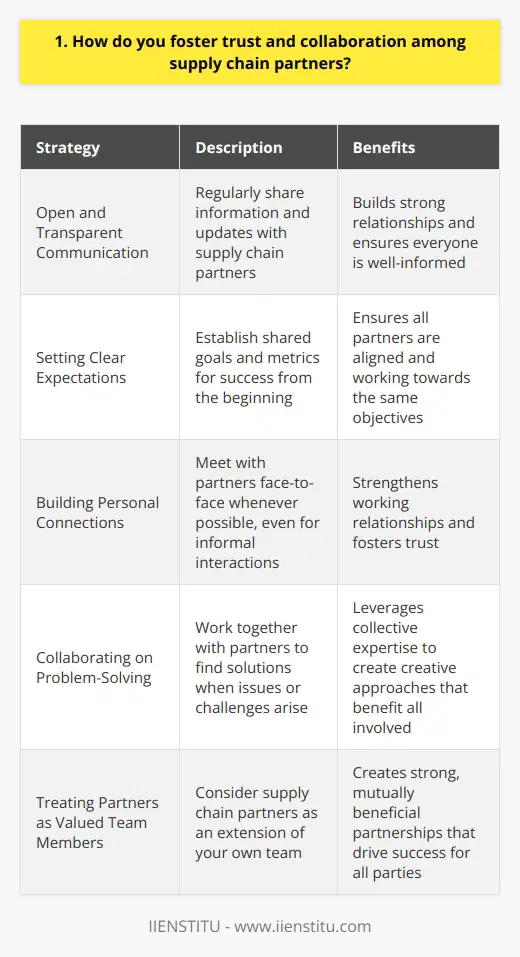
2. What strategies do you employ to ensure effective communication in a complex supply chain network?
As a supply chain professional, I understand the importance of effective communication in complex networks. Over the years, I've developed several strategies to ensure smooth information flow and collaboration among stakeholders.
Building Strong Relationships
I believe that trust and rapport are the foundation of effective communication. I make it a point to regularly connect with suppliers, distributors, and colleagues, both formally and informally. Sharing a cup of coffee or a quick phone call goes a long way in fostering open dialogue and understanding each other's challenges and goals.
Leveraging Technology
In today's fast-paced world, technology is a game-changer. I'm always on the lookout for tools that can streamline communication and improve visibility across the supply chain. From cloud-based collaboration platforms to real-time tracking systems, I've seen firsthand how technology can break down silos and keep everyone on the same page.
Practicing Active Listening
Communication is a two-way street. I've learned that actively listening to others' concerns and ideas is just as important as clearly conveying my own thoughts. By creating a safe space for open dialogue and being receptive to feedback, I've been able to build consensus and find creative solutions to complex problems.
Adapting to Cultural Differences
Working in a global supply chain means navigating cultural nuances. I've made it a priority to educate myself on the communication styles and preferences of my international partners. Whether it's being mindful of time zones or learning a few key phrases in their language, these small gestures have helped me build bridges and avoid misunderstandings.
At the end of the day, effective communication in a complex supply chain network comes down to empathy, adaptability, and a willingness to collaborate. By fostering strong relationships, leveraging technology, practicing active listening, and respecting cultural differences, I've been able to drive positive results and keep the supply chain running smoothly.
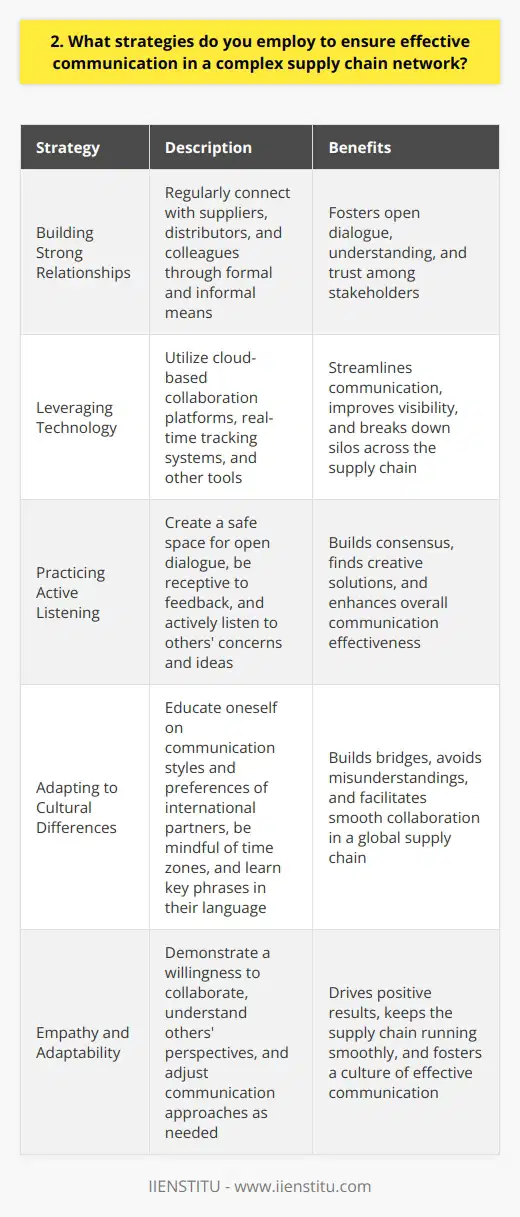
3. How do you manage conflicts and resolve disputes with suppliers or customers?
I believe that effective communication and a solution-oriented approach are key to resolving conflicts with suppliers or customers. When a dispute arises, I first seek to understand the root cause of the issue by actively listening to the concerns of all parties involved.
Gathering Information
I ask clarifying questions to gather all relevant information and perspectives. This helps me identify the underlying needs and interests of each party, rather than focusing solely on their stated positions.
Finding Common Ground
Once I have a clear understanding of the situation, I work to find common ground and explore potential solutions that address the needs of both parties. I believe that most conflicts can be resolved through collaboration and compromise.
Proposing Solutions
I propose creative solutions that balance the interests of all stakeholders. I'm not afraid to think outside the box and suggest innovative approaches to resolve the issue.
Implementing Agreements
After reaching an agreement, I ensure that all parties understand their responsibilities and commitments. I follow up to make sure the solution is implemented effectively and the conflict is fully resolved.
Throughout the process, I maintain a professional and respectful demeanor, even in challenging situations. I believe that by approaching conflicts with empathy, open-mindedness, and a focus on solutions, we can strengthen our relationships with suppliers and customers and prevent future disputes from arising.
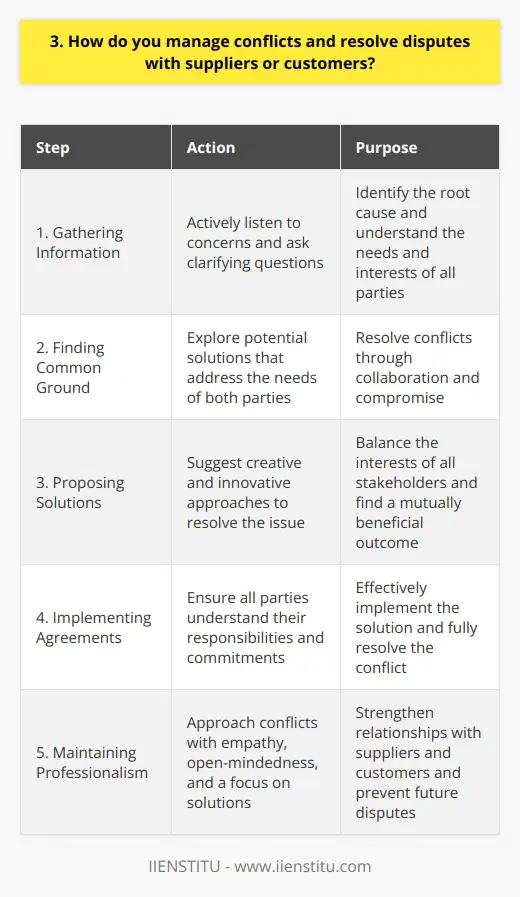
4. What methods do you use to monitor and evaluate the performance of supply chain relationships?
I use a combination of quantitative and qualitative methods to monitor and evaluate supply chain relationships. This includes:
Regular Performance Reviews
I schedule periodic meetings with suppliers to discuss their performance against agreed-upon metrics. We review quality, delivery times, responsiveness, and other key indicators. These discussions help identify areas for improvement and ensure we're on the same page.
Site Visits and Audits
There's no substitute for seeing operations firsthand. I visit supplier facilities to observe their processes, quality control measures, and working conditions. Audits help verify they are meeting our standards and contractual requirements.
Supplier Scorecards
I maintain a scorecard for each critical supplier, tracking their performance over time on the metrics that matter most to us. This helps spot trends and gives an objective basis for discussions. Top performers may earn more business while chronic underperformers risk being cut.
360-Degree Feedback
Input from stakeholders across our organization is invaluable - from Procurement and Quality to Manufacturing and Finance. I solicit their views on what's working well and what could be better with each key supplier relationship. Taking a holistic view helps assess the true value each partner delivers.
Proactive Communication
Perhaps most importantly, I believe in open, frequent dialogue with our suppliers. Honest conversations build trust and surface issues before they become major problems. By proactively communicating and collaborating with our supply chain partners, we lay the foundation for long-term, mutually beneficial relationships. It's an approach that has served me well thus far in my career.
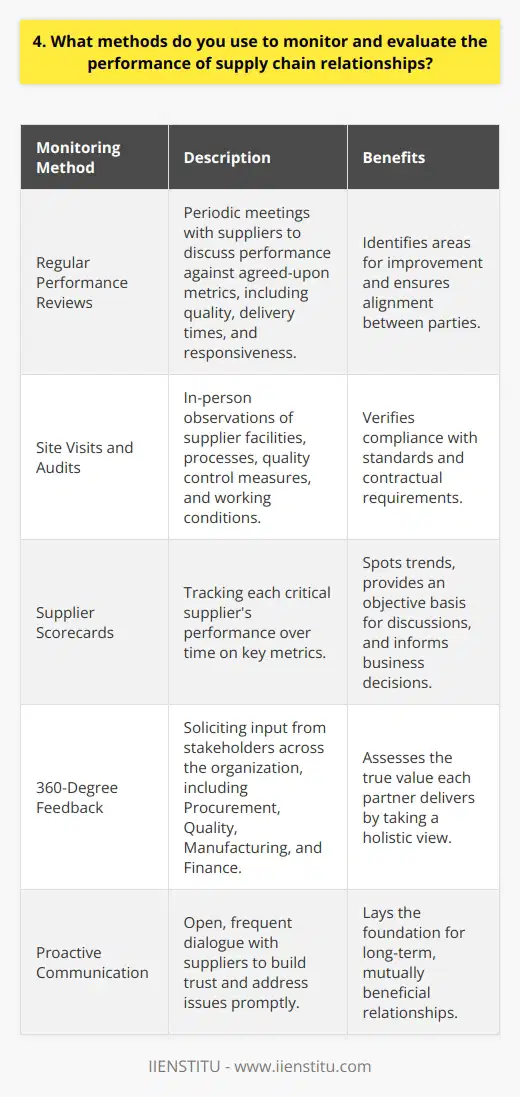
5. How do you adapt your relationship management approach to different cultural contexts?
When adapting my relationship management approach to different cultural contexts, I always strive to be respectful and open-minded. I take the time to learn about the specific customs, values, and communication styles of the culture I'm working with. This helps me to build trust and rapport with colleagues and clients from diverse backgrounds.
Researching Cultural Norms
Before engaging with individuals from a different culture, I make sure to do my homework. I read up on their cultural practices, business etiquette, and social norms. This allows me to avoid unintentional faux pas and show that I value their traditions.
Adapting Communication Style
I pay close attention to how people from different cultures communicate, both verbally and nonverbally. In some cultures, direct eye contact is expected, while in others it may be considered rude. I adjust my body language and tone accordingly to make others feel comfortable.
I also consider language barriers and try to speak clearly and avoid idioms or slang that may not translate well. If needed, I'm happy to work with interpreters to ensure accurate communication.
Building Personal Connections
No matter the cultural context, I believe that building genuine personal connections is key to successful relationship management. I take interest in learning about my colleagues' and clients' lives, families, and hobbies outside of work. Sharing a meal or attending a cultural event together can go a long way in fostering strong bonds.
Embracing Diversity
Ultimately, I view working across different cultures as an incredible opportunity for personal and professional growth. By embracing diversity and approaching cultural differences with curiosity and respect, I'm able to build rich, meaningful relationships with people from all walks of life. These relationships not only benefit me personally, but also help to drive successful business outcomes.
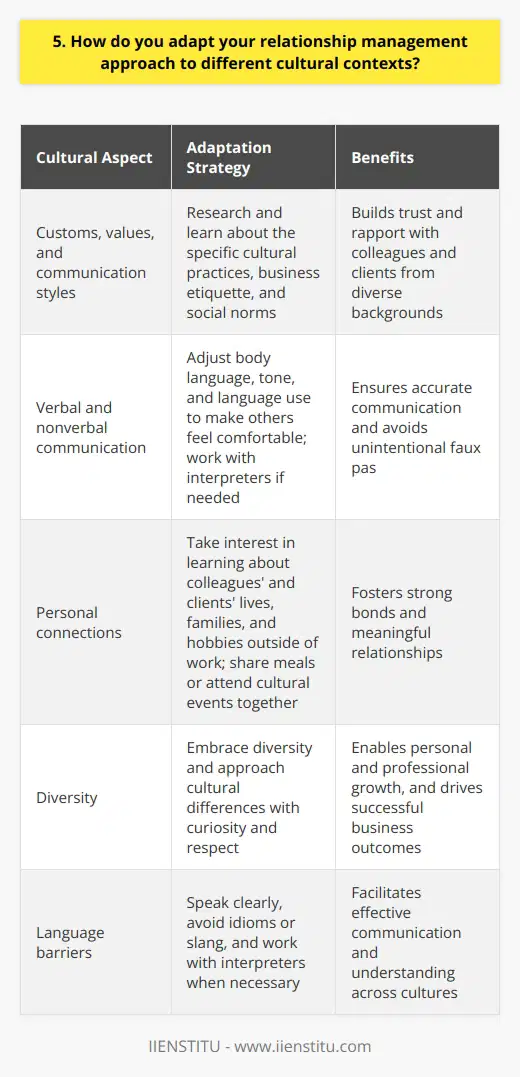
6. What role does technology play in maintaining and enhancing supply chain relationships?
Technology plays a crucial role in maintaining and enhancing supply chain relationships. I've seen firsthand how it streamlines communication and collaboration between partners.
Real-Time Data Sharing
By leveraging cloud-based platforms, supply chain partners can share real-time data effortlessly. This transparency fosters trust and enables quick decision-making.
I remember implementing a cloud solution at my previous company. It transformed how we collaborated with suppliers and customers.
Automation and Efficiency
Automation technologies, such as robotic process automation (RPA), eliminate manual tasks and reduce errors. This efficiency boost strengthens relationships by ensuring smooth operations.
In my experience, automating key processes like order processing and inventory management significantly improved our partnerships. It freed up time for strategic discussions.
Predictive Analytics
Predictive analytics helps forecast demand, optimize inventory, and identify potential disruptions. By sharing these insights, supply chain partners can proactively address challenges together.
I've seen how predictive analytics can predict market trends and customer preferences. It's a game-changer for building resilient relationships.
Collaborative Platforms
Technology enables the creation of collaborative platforms where supply chain partners can communicate, share documents, and track progress seamlessly.
I've used platforms like Slack and Microsoft Teams to foster real-time collaboration with partners. It's incredible how it brings teams closer, despite geographical distances.
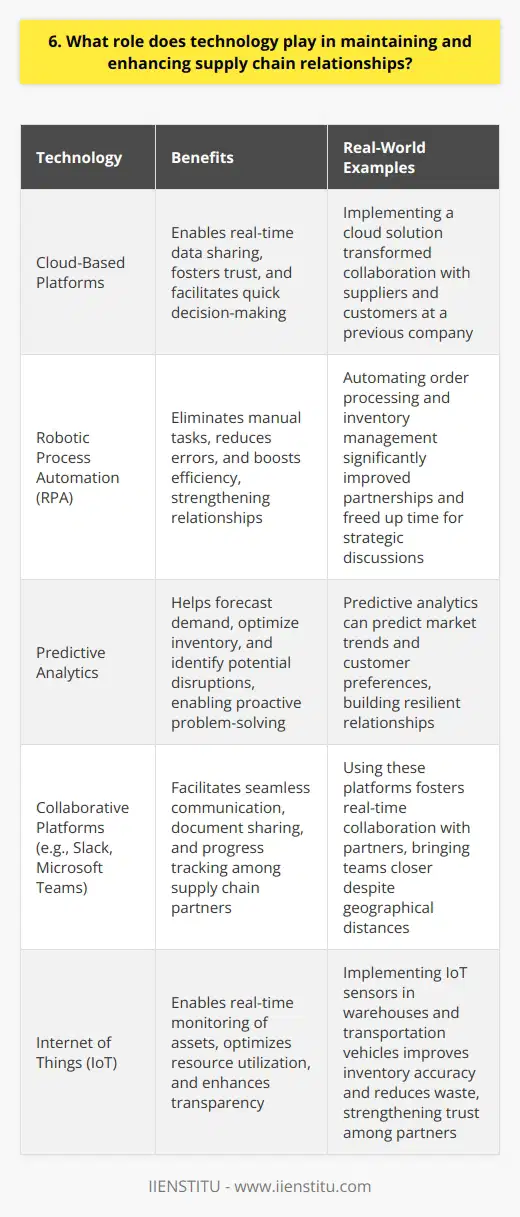
7. How do you balance the need for flexibility and adaptability with the desire for long-term partnerships?
I believe that flexibility and adaptability are crucial in today's fast-paced business environment. However, I also recognize the importance of building long-term partnerships with clients, colleagues, and stakeholders. Balancing these two aspects requires open communication, trust, and a shared vision.
Embracing Change While Maintaining Stability
I approach this balance by being open to new ideas and willing to adapt my approach when necessary. At the same time, I strive to maintain a sense of stability and consistency in my work. This allows me to build strong relationships based on reliability and trust.
Collaborating for Long-Term Success
When working with partners, I focus on understanding their needs and goals. By aligning our objectives and maintaining transparent communication, we can navigate changes together while keeping our long-term vision in mind. I believe that collaboration and mutual understanding are key to achieving lasting success.
Personal Example
In my previous role, I worked closely with a client on a long-term project. Throughout the project, we encountered several unexpected challenges that required us to adapt our strategy. By maintaining open lines of communication and being flexible in our approach, we were able to successfully navigate these changes while strengthening our partnership.
Continuous Learning and Growth
I believe that embracing flexibility and adaptability also means being open to continuous learning and growth. By staying curious and actively seeking new knowledge and skills, I can better respond to changing circumstances while adding value to long-term partnerships.
Ultimately, balancing flexibility with long-term partnerships requires a commitment to communication, collaboration, and a shared vision for success. By embracing change while maintaining strong relationships, we can navigate the ever-evolving business landscape together.
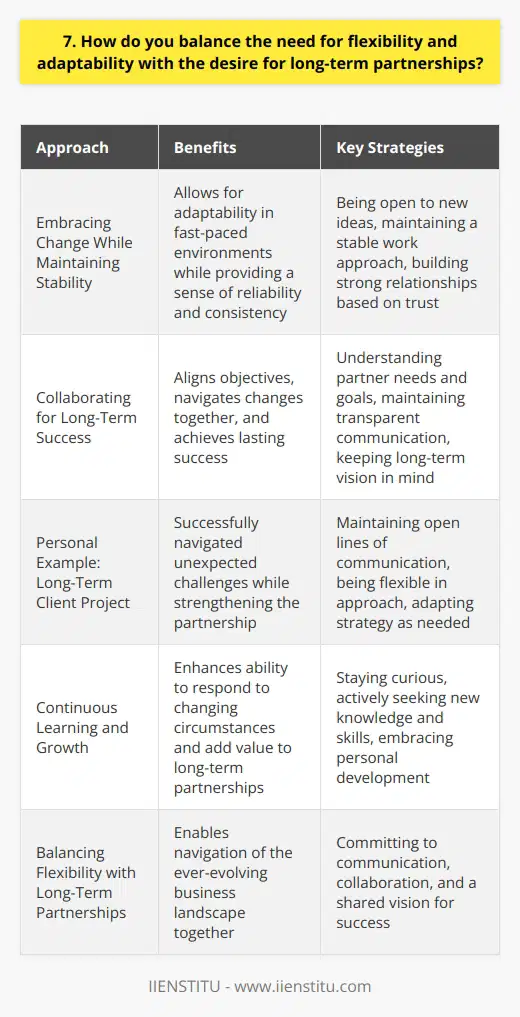
8. What are the key challenges in managing relationships with suppliers located in different regions or countries?
Managing relationships with suppliers located in different regions or countries presents several key challenges. Communication barriers, cultural differences, and time zone variations can make it difficult to maintain smooth and efficient interactions. It's crucial to establish clear lines of communication and set expectations early on to avoid misunderstandings and delays.
Navigating Cultural Differences
When I worked with suppliers in Asia, I quickly learned that cultural norms and business practices varied significantly from what I was used to in the United States. For example, in some cultures, it's considered disrespectful to say "no" directly, so suppliers may agree to unrealistic deadlines or requirements to avoid conflict. It's important to be aware of these differences and adapt your communication style accordingly.
Managing Logistics and Supply Chain Risks
Distance and transportation logistics can also pose significant challenges when working with international suppliers. Shipping delays, customs issues, and unexpected events like natural disasters or political instability can disrupt supply chains and impact project timelines. In my experience, it's essential to have contingency plans in place and maintain open communication with suppliers to mitigate these risks.
Building Trust and Long-Term Partnerships
Despite the challenges, I believe that investing time and effort into building strong relationships with international suppliers is well worth it. By fostering trust, mutual understanding, and long-term partnerships, you can unlock the benefits of global sourcing while minimizing the risks. It's not always easy, but the rewards can be substantial.
In conclusion, managing supplier relationships across borders requires patience, adaptability, and a willingness to learn and embrace different perspectives. It's a complex but rewarding aspect of global business that I find both challenging and fulfilling.
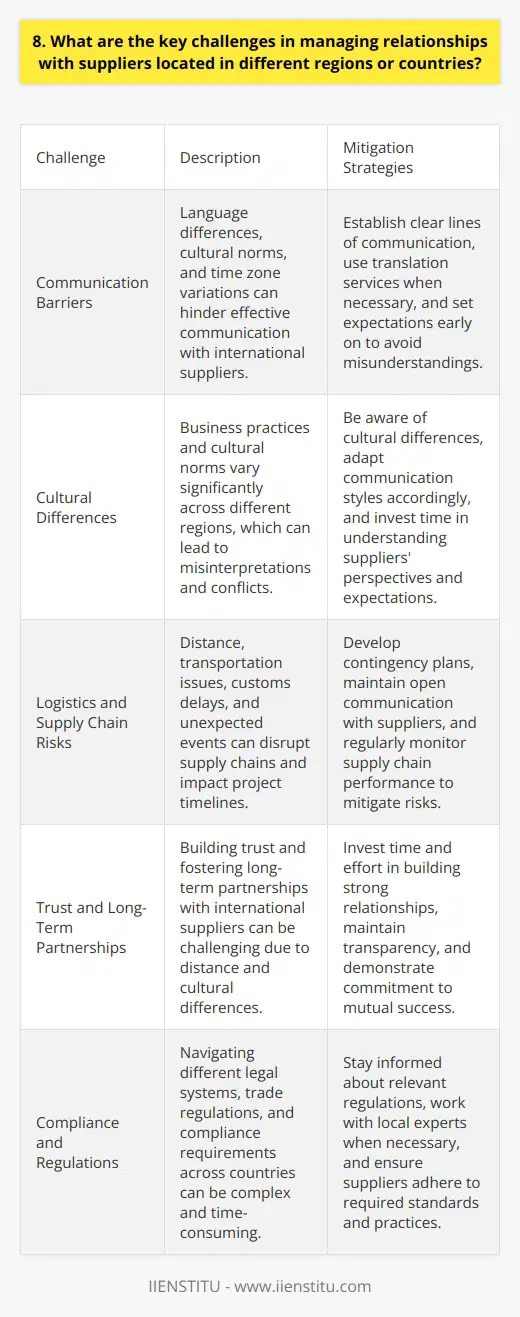
9. How do you ensure that all supply chain partners adhere to ethical and sustainable practices?
As a supply chain manager, I understand the importance of ethical and sustainable practices throughout the entire supply chain. To ensure that all partners adhere to these standards, I take a proactive and collaborative approach.
Establishing Clear Guidelines and Expectations
From the very beginning of any partnership, I make our company's values and expectations crystal clear. We have a comprehensive code of conduct that outlines our standards for ethical behavior, fair labor practices, and environmental sustainability. I personally discuss these guidelines with each partner to ensure they fully understand and commit to upholding them.
Regular Audits and Inspections
Trust is important, but verification is crucial. That's why I implement a robust system of regular audits and on-site inspections. My team and I visit our partners' facilities, interview workers, and review documentation to confirm compliance with our standards. We also conduct surprise inspections to get an authentic picture of day-to-day operations.
Collaboration and Support
I believe in working closely with our partners to help them continuously improve their practices. If we identify areas for improvement during an audit, we don't just issue a warning or penalty. Instead, we collaborate with the partner to develop a corrective action plan and provide resources and support to help them implement necessary changes.
Transparency and Accountability
I hold ourselves and our partners accountable through transparent reporting and communication. We regularly share progress updates and sustainability metrics with stakeholders, and we're open about challenges and areas for improvement. If a partner consistently fails to meet our standards despite our support efforts, we're prepared to terminate the relationship.
At the end of the day, ensuring ethical and sustainable practices is about more than just compliance – it's about building a supply chain that we can all be proud of. By setting clear expectations, monitoring closely, collaborating with partners, and maintaining transparency, I work hard to make that vision a reality.

10. What strategies do you use to align the goals and objectives of different supply chain members?
To align the goals and objectives of different supply chain members, I focus on several key strategies:
Open Communication and Collaboration
I believe in fostering open lines of communication among all supply chain stakeholders. By encouraging regular meetings and discussions, we can ensure everyone is on the same page and working towards common goals. Collaboration is essential for identifying potential issues and finding mutually beneficial solutions.
Shared Vision and Objectives
I work with supply chain members to develop a shared vision and set of objectives. By aligning our goals from the outset, we can avoid conflicts down the line. It's important to consider each member's unique needs and priorities while finding common ground.
Data-Driven Decision Making
I rely on data and analytics to inform decision making and goal setting. By utilizing supply chain metrics and KPIs, we can identify areas for improvement and track progress towards our objectives. Data helps us make informed choices that benefit the entire supply chain.
Continuous Improvement and Adaptability
Supply chains are dynamic, so our goals and strategies must be adaptable. I encourage continuous improvement initiatives to optimize processes and align objectives. By staying flexible and open to change, we can respond to market fluctuations and changing customer demands.
In my experience, aligning supply chain goals requires a combination of communication, collaboration, shared vision, data-driven insights, and adaptability. By working together towards common objectives, we can create a more efficient, resilient, and successful supply chain.
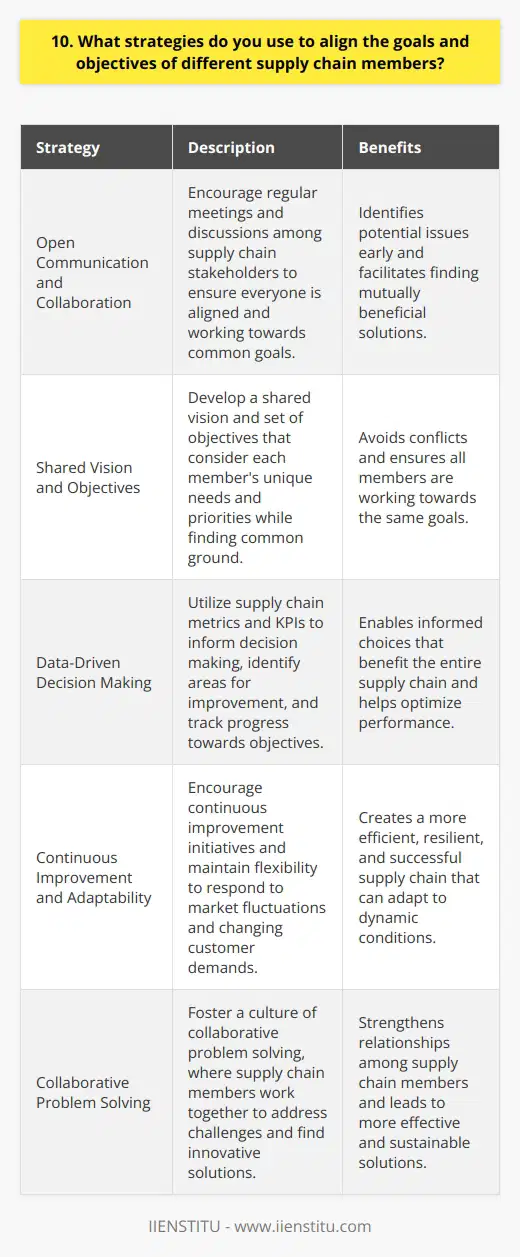
11. How do you foster innovation and continuous improvement in supply chain relationships?
I foster innovation and continuous improvement in supply chain relationships through several key strategies. First, I prioritize open communication and collaboration with suppliers. Regular meetings and discussions help identify areas for improvement and spark new ideas.
Encouraging Experimentation
I encourage suppliers to experiment with new processes, materials, or technologies. Pilot projects and small-scale trials can test innovative concepts without major risk. Successes can then be rolled out more broadly for greater impact.
Sharing Data and Insights
Exchanging data, market research, and consumer insights with supply chain partners fosters alignment and innovation. Understanding evolving trends and preferences helps us develop products and solutions that meet changing needs.
Investing in Technology
I advocate for investing in technologies that streamline processes and enable innovation, such as AI, IoT, and blockchain. These tools enhance transparency, automate tasks, and provide valuable data for decision-making.
Recognizing and Rewarding Innovation
To sustain a culture of continuous improvement, I believe in recognizing and rewarding supplier innovations. Celebrating successes, offering incentives, and showcasing achievements encourages ongoing creativity and collaboration.
Ultimately, fostering innovation in supply chain relationships requires a proactive, collaborative approach. By working closely with suppliers, sharing knowledge, and leveraging technology, we can drive meaningful advancements that benefit everyone.
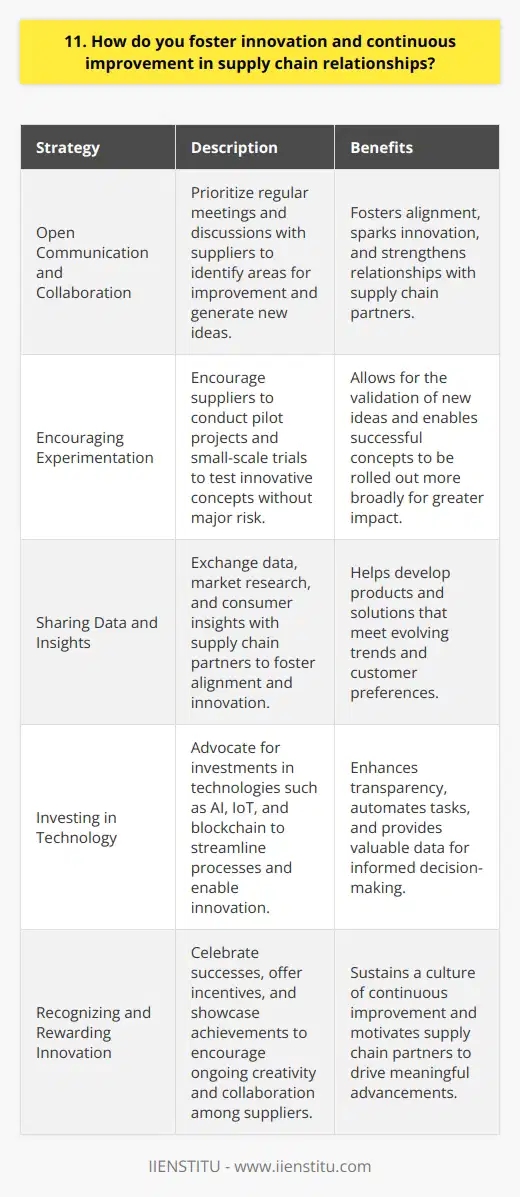
12. What are the most effective ways to share knowledge and best practices among supply chain partners?
To effectively share knowledge and best practices among supply chain partners, I believe open communication is key. In my experience, regular meetings and discussions help keep everyone on the same page. Whether it's in-person gatherings or virtual conferences, face-to-face interactions facilitate a deeper understanding of each other's processes and challenges.
Leverage Technology
Another powerful tool for knowledge sharing is technology. At my previous company, we used a cloud-based platform to store and share documents, reports, and data. This centralized repository made it easy for partners to access the latest information anytime, anywhere. It also enabled real-time collaboration and reduced the risk of miscommunication.
Encourage Informal Sharing
While formal channels are important, I've found that informal knowledge sharing can be just as valuable. Encouraging supply chain partners to connect on a personal level, through casual conversations or social events, fosters trust and rapport. These relationships make it more likely for people to reach out when they have questions or ideas to share.
Recognize and Reward Sharing
Finally, I think it's crucial to create a culture that values knowledge sharing. Recognizing and rewarding individuals who actively contribute their expertise sends a strong message. It shows that the organization prioritizes continuous learning and improvement. When people feel appreciated for sharing, they're more motivated to keep doing it.
Of course, every supply chain is unique, and what works for one may not work for another. The key is to stay open-minded, experiment with different approaches, and continuously evaluate and refine your knowledge-sharing strategies. With the right mindset and tools, I believe any supply chain can unlock the power of collective wisdom.
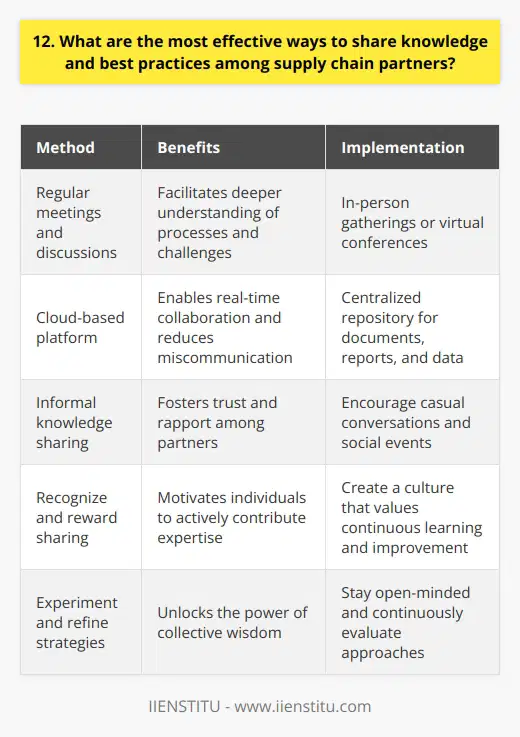
13. How do you manage the risks associated with relying on external partners in your supply chain?
As a supply chain professional, I understand the importance of managing risks associated with external partners. It's crucial to have a robust risk management strategy in place to ensure the smooth flow of operations and minimize potential disruptions.
Thorough Vetting Process
When selecting external partners, I always conduct a thorough vetting process. This includes assessing their financial stability, reputation, and track record. I look for partners who have a proven history of reliability and quality service.
Additionally, I ensure that our partners align with our company's values and ethical standards. We can't afford to work with suppliers who don't share our commitment to integrity and sustainability.
Clear Communication and Expectations
Once we've chosen our partners, I establish clear lines of communication and set explicit expectations from the outset. This involves defining key performance indicators (KPIs) and establishing regular check-ins to monitor progress.
I believe in fostering strong relationships with our partners built on trust and transparency. By maintaining open dialogue, we can quickly address any issues that arise and work together to find solutions.
Contingency Planning
Despite our best efforts, unforeseen circumstances can always occur. That's why I make sure to have contingency plans in place for our critical suppliers. This might include identifying backup suppliers or stockpiling essential materials.
By anticipating potential risks and having a plan B ready, we can minimize the impact of any disruptions and keep our operations running smoothly.
Continuous Monitoring and Improvement
Finally, I believe in continuously monitoring and improving our risk management processes. This means regularly auditing our suppliers, tracking key metrics, and staying up-to-date with industry best practices.
By taking a proactive approach to risk management, we can build a more resilient supply chain that can weather any storm. It's an ongoing process that requires dedication and vigilance, but it's essential for long-term success.
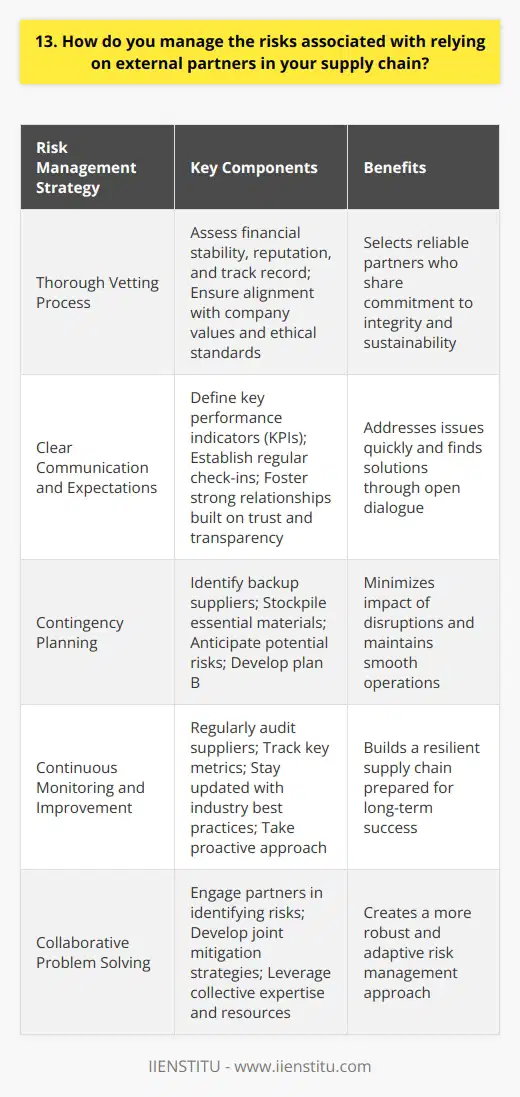
14. What are the key considerations when selecting new suppliers or partners for your supply chain?
When selecting new suppliers or partners for my supply chain, I always consider several key factors. First and foremost, I look for companies that align with our values and prioritize quality and reliability. I want partners who consistently deliver on their promises and maintain high standards.
Assessing Capabilities and Resources
It's crucial to evaluate a potential supplier's capabilities and resources. Do they have the necessary expertise, technology, and capacity to meet our specific needs? I dig deep into their track record and seek out references from their current clients. This due diligence helps me gauge their ability to handle our requirements effectively.
Building Strong Relationships
I believe in fostering strong, collaborative relationships with our supply chain partners. Open communication, trust, and a shared commitment to success are essential. I look for suppliers who are responsive, proactive, and willing to work closely with us to overcome challenges and seize opportunities.
Embracing Innovation and Continuous Improvement
In today's fast-paced business environment, it's important to partner with suppliers who embrace innovation and continuous improvement. I seek out companies that invest in cutting-edge technologies, streamline processes, and actively seek ways to optimize efficiency and reduce waste. By collaborating with forward-thinking partners, we can stay ahead of the curve and drive positive change throughout our supply chain.
Ultimately, selecting the right suppliers and partners is a critical decision that can significantly impact our business. By carefully considering these key factors and building strong, strategic relationships, we can create a resilient and high-performing supply chain that delivers value to our customers and drives our long-term success.
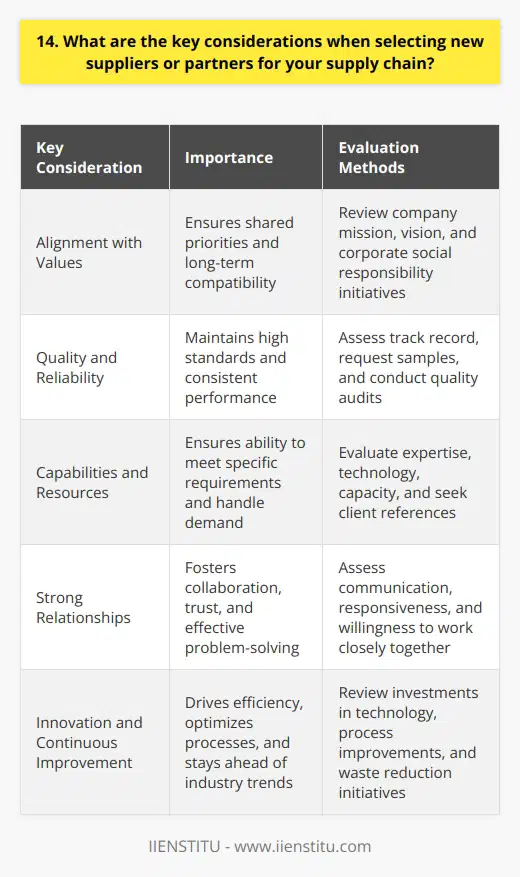
15. How do you ensure that your supply chain relationships are resilient to disruptions and crises?
To ensure supply chain resilience, I prioritize strong communication and collaboration with my suppliers. I maintain regular contact through various channels, including face-to-face meetings, phone calls, and email, to stay informed about their operations and any potential disruptions.
Diversifying Suppliers
I also work to diversify my supplier base, identifying multiple sources for critical components and materials. This helps to mitigate the risk of disruptions from any single supplier.
Building Inventory Buffers
Another strategy I employ is building inventory buffers for critical items. By maintaining a safety stock, I can continue operations even if there are temporary disruptions in the supply chain.
Monitoring and Risk Assessment
I continuously monitor market trends, geopolitical events, and other factors that could impact the supply chain. By staying informed, I can anticipate potential disruptions and take proactive measures to mitigate their impact.
Flexibility and Adaptability
Finally, I prioritize flexibility and adaptability in my supply chain relationships. I work with suppliers who are willing to be creative and find alternative solutions when disruptions occur. By fostering a culture of collaboration and problem-solving, we can navigate even the most challenging situations together.
In my experience, these strategies have helped me maintain a resilient supply chain that can withstand disruptions and crises. I'm confident that I can bring this same approach to your organization and ensure the continuity of our operations.

16. What metrics do you use to assess the health and value of your supply chain relationships?
When assessing the health and value of supply chain relationships, I focus on several key metrics. These include:
Communication and Collaboration
I believe that open, frequent communication is essential for strong supply chain partnerships. I look for suppliers who are responsive, transparent, and willing to work together to solve problems and improve processes.
Quality and Reliability
Consistent quality and on-time delivery are critical. I track supplier performance metrics like defect rates, lead times, and fill rates to ensure they meet our standards and support our production needs.
Cost and Value
While price is important, I also consider the total value a supplier provides. This includes factors like innovation, flexibility, and the ability to scale with our business as it grows.
Risk Management
I assess suppliers' financial stability, business continuity plans, and compliance with regulations and ethical standards. Proactively identifying and mitigating supply chain risks helps protect our company's reputation and bottom line.
Continuous Improvement
The best supply chain relationships are those that evolve and improve over time. I look for suppliers who are committed to ongoing optimization, innovation, and waste reduction to drive mutual benefits.
By regularly monitoring these metrics and maintaining close, collaborative relationships with our suppliers, I aim to build a resilient, high-performing supply chain that supports our company's long-term success.
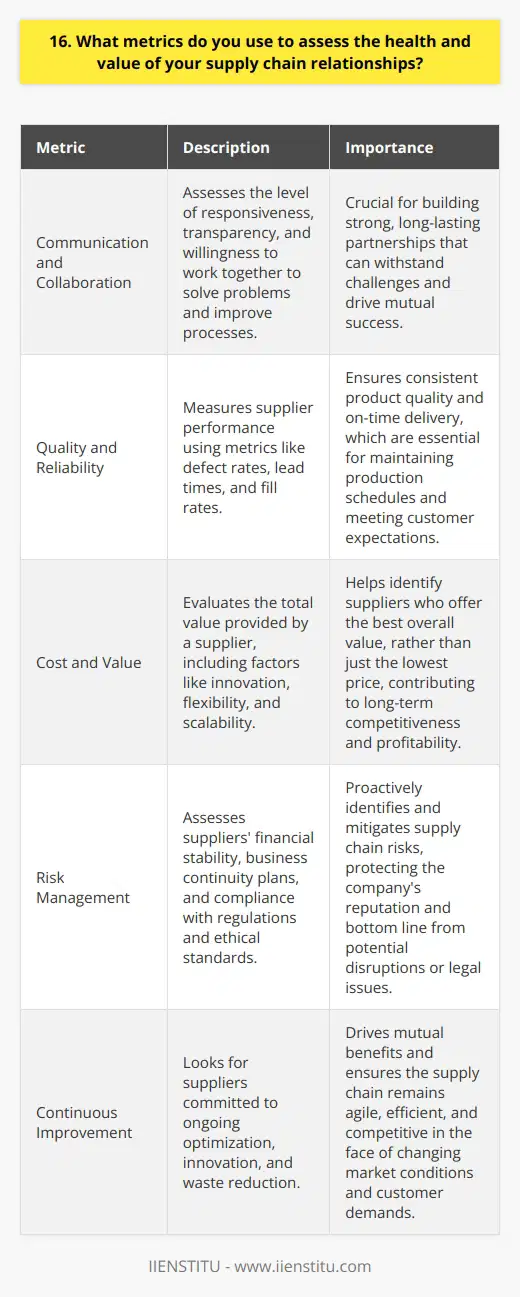
17. How do you balance the need for cost efficiency with the importance of maintaining strong relationships?
Balancing cost efficiency and strong relationships is a delicate dance, but one that's crucial for long-term success. In my experience, the key is to approach every decision with a holistic mindset, considering both the financial implications and the potential impact on partnerships.
Prioritizing Open Communication
I believe that open, honest communication is the foundation of any strong relationship, whether it's with clients, suppliers, or team members. By keeping lines of communication open, you can identify potential issues early on and work together to find solutions that benefit everyone involved.
Real-World Example
In my previous role, we faced a situation where a key supplier increased their prices unexpectedly. Rather than simply cutting ties to save costs, I scheduled a meeting with their team to discuss our concerns and explore alternative options. Through open dialogue, we were able to negotiate a mutually beneficial arrangement that maintained the quality of our products while also keeping costs in check.
Focusing on Long-Term Value
While short-term cost savings can be tempting, I've learned that it's essential to consider the long-term value of relationships. Sometimes, investing a bit more upfront can lead to significant benefits down the road, such as increased loyalty, enhanced collaboration, and shared growth opportunities.
Personal Anecdote
I once worked with a client who had a limited budget but showed incredible potential. Despite the short-term financial hit, I decided to dedicate extra time and resources to help them succeed. Over time, they grew into one of our most valuable and loyal clients, referring new business and collaborating on innovative projects that drove our company forward.
In summary, balancing cost efficiency and strong relationships requires a strategic, long-term approach. By prioritizing open communication, focusing on shared value, and being willing to invest in the success of others, I believe we can build lasting partnerships that drive meaningful results for all involved.
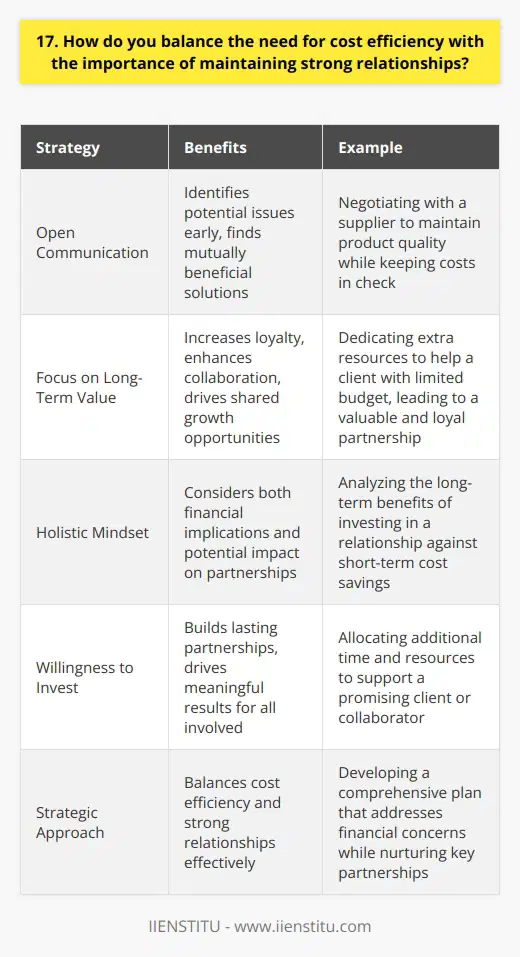
18. What role does leadership play in fostering positive relationships throughout the supply chain?
Leadership plays a crucial role in fostering positive relationships throughout the supply chain. In my experience, effective leaders communicate clearly and regularly with suppliers, building trust and mutual understanding. They also collaborate closely with partners to identify areas for improvement and implement solutions together.
Empowering Suppliers
I believe great leaders empower their suppliers to succeed. They provide training, resources, and support to help vendors meet quality and delivery targets. When issues arise, they work with suppliers to troubleshoot rather than simply issuing penalties. This collaborative approach strengthens relationships.
Aligning Goals
Successful supply chain leaders ensure everyone is working towards the same objectives. They clearly communicate the company's vision, strategies, and targets. Suppliers who understand the big picture are more engaged and committed to mutual success in my opinion.
Rewarding Performance
In addition to holding suppliers accountable, I think it's important for leaders to recognize and reward outstanding contributions. Public acknowledgment, expanded contracts, and referrals to other divisions strengthen vendor loyalty and performance. A leader who expresses genuine appreciation builds goodwill.
Investing in Relationships
Finally, I've found that the best supply chain leaders invest time in developing personal connections with suppliers. They visit supplier facilities, invite them to company events, and get to know them outside of work. These efforts foster a spirit of partnership.
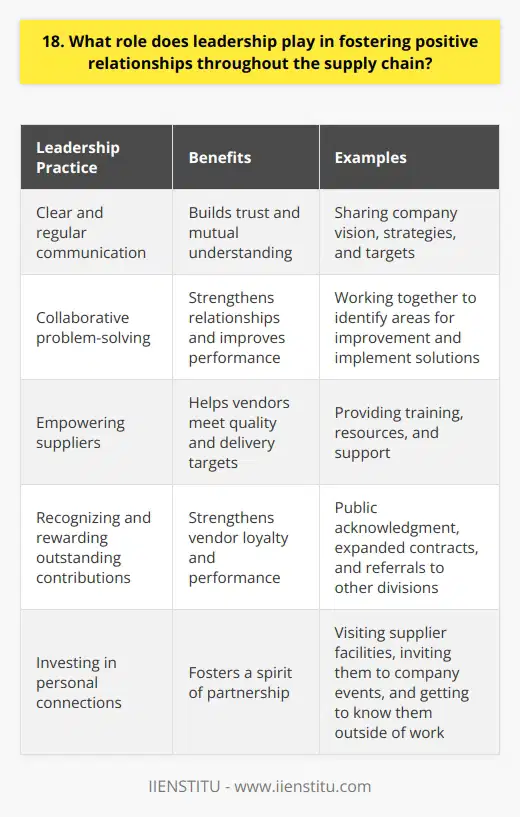
19. How do you manage the power dynamics and dependencies within your supply chain network?
As a supply chain manager, I understand the importance of managing power dynamics and dependencies within the network. It's a complex task that requires a strategic approach and effective communication skills.
Building Strong Relationships
One of the key aspects of managing power dynamics is building strong relationships with suppliers and partners. I make it a point to regularly engage with them, understand their challenges, and work together to find mutually beneficial solutions. By fostering a collaborative environment, we can minimize conflicts and ensure a smooth flow of goods and services.
Diversifying Suppliers
To reduce dependencies and mitigate risks, I actively seek to diversify our supplier base. By having multiple sources for critical components or raw materials, we can avoid being overly reliant on a single supplier. This not only helps us maintain a stable supply chain but also gives us leverage in negotiations.
Transparent Communication
Clear and transparent communication is crucial in managing power dynamics. I ensure that expectations, deadlines, and quality standards are communicated effectively to all parties involved. Regular meetings and progress updates help keep everyone on the same page and prevent misunderstandings or conflicts from arising.
Continuous Monitoring and Evaluation
I believe in continuously monitoring and evaluating the performance of our supply chain partners. By setting key performance indicators (KPIs) and regularly assessing their performance, we can identify areas for improvement and address any issues promptly. This helps maintain a healthy balance of power and ensures that all parties are meeting their obligations.
Collaborative Problem Solving
When conflicts or challenges arise, I adopt a collaborative problem-solving approach. Instead of using our position of power to force a solution, I engage in open discussions with our partners to understand their perspectives and find mutually agreeable solutions. By working together, we can overcome obstacles and strengthen our relationships in the long run.
Managing power dynamics and dependencies in a supply chain network is an ongoing process that requires adaptability, communication, and a strategic mindset. By building strong relationships, diversifying suppliers, maintaining transparent communication, continuously monitoring performance, and embracing collaborative problem-solving, I strive to create a resilient and efficient supply chain that benefits all stakeholders involved.
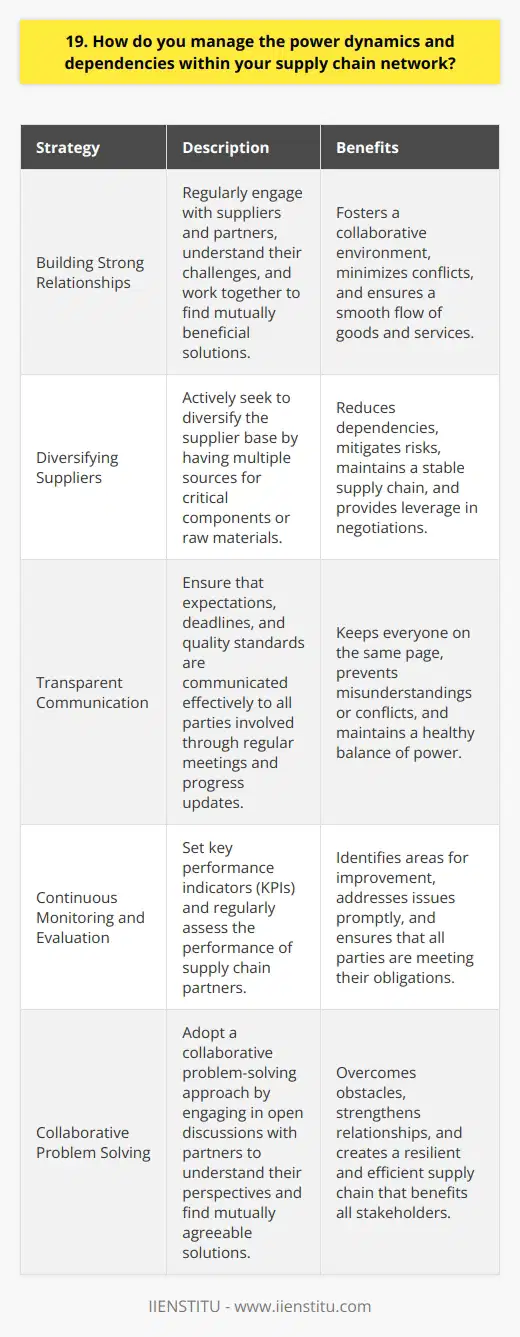
20. What are the most effective ways to incentivize and motivate supply chain partners?
The most effective ways to incentivize and motivate supply chain partners are through a combination of financial rewards, recognition, and strong relationships. By offering competitive pricing and profit-sharing opportunities, you can encourage partners to prioritize your business and deliver exceptional results.
Recognize and Celebrate Achievements
Take the time to acknowledge the hard work and successes of your supply chain partners. Celebrate milestones together and publicly recognize their contributions to your shared goals. A simple thank-you note or a thoughtful gift can go a long way in strengthening your partnership.
Foster Open Communication and Collaboration
Maintain open lines of communication with your partners. Schedule regular check-ins to discuss progress, challenges, and opportunities for improvement. Encourage a collaborative environment where ideas are freely shared and everyone feels valued. When partners feel heard and supported, they are more likely to go above and beyond.
Invest in Long-Term Relationships
Building strong, long-term relationships with your supply chain partners is crucial. Take the time to understand their business, their challenges, and their goals. Look for ways to support their growth and success, even if it doesn't directly benefit you in the short term. When partners feel like you are invested in their success, they will be more motivated to support yours.
By focusing on financial incentives, recognition, communication, and long-term relationships, you can create a motivated and engaged supply chain that delivers exceptional results.
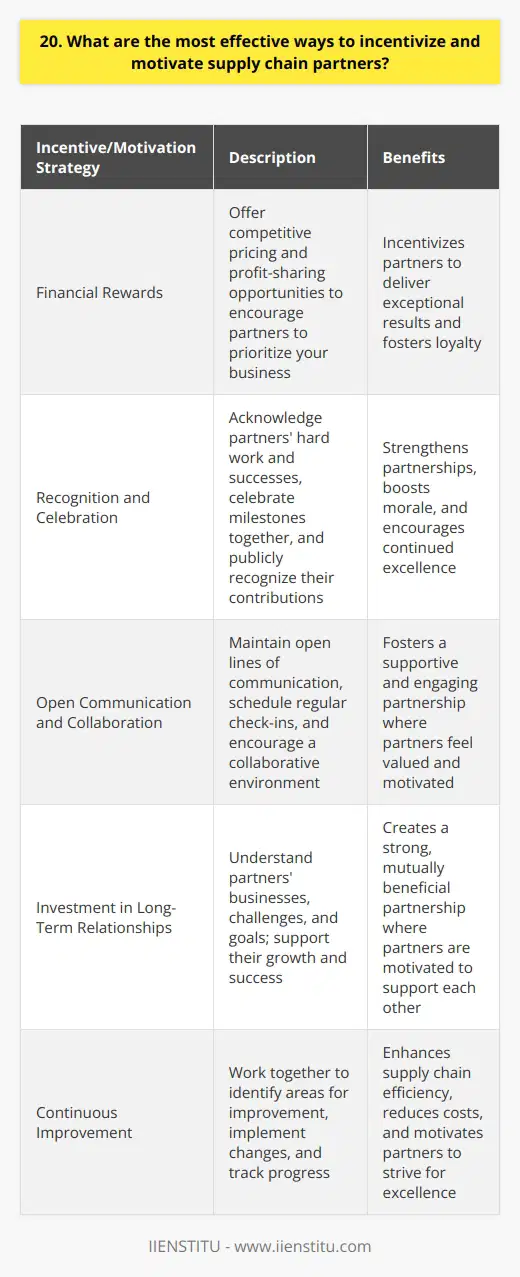
21. How do you ensure that your supply chain relationships are aligned with your overall business strategy?
I ensure that my supply chain relationships align with my overall business strategy through effective communication and collaboration. I work closely with suppliers to understand their capabilities and align them with our company's goals. This involves:
Building Strong Partnerships
I invest time in developing strong, long-term relationships with key suppliers. By fostering trust and open communication, we can work together to achieve our shared objectives.
For example, I recently worked with a supplier to develop a new, eco-friendly packaging solution. By collaborating closely, we were able to create a solution that met our sustainability goals while also reducing costs.
Aligning Metrics and Incentives
I ensure that our suppliers' metrics and incentives are aligned with our own. This means setting clear performance expectations and rewarding suppliers who help us achieve our strategic goals.
In my previous role, I implemented a supplier scorecard system that tracked key metrics like on-time delivery and quality. Suppliers who performed well were rewarded with increased business, creating a win-win situation.
Continuously Improving
I believe in continuous improvement and work with suppliers to identify opportunities for optimization. By sharing data and insights, we can find ways to streamline processes, reduce waste, and drive innovation.
I'm always looking for ways to leverage new technologies and best practices to improve our supply chain. Whether it's implementing a new inventory management system or exploring alternative materials, I'm committed to finding solutions that benefit both our company and our suppliers.
Ultimately, by aligning our supply chain relationships with our business strategy, we can create a more resilient, responsive, and competitive organization.
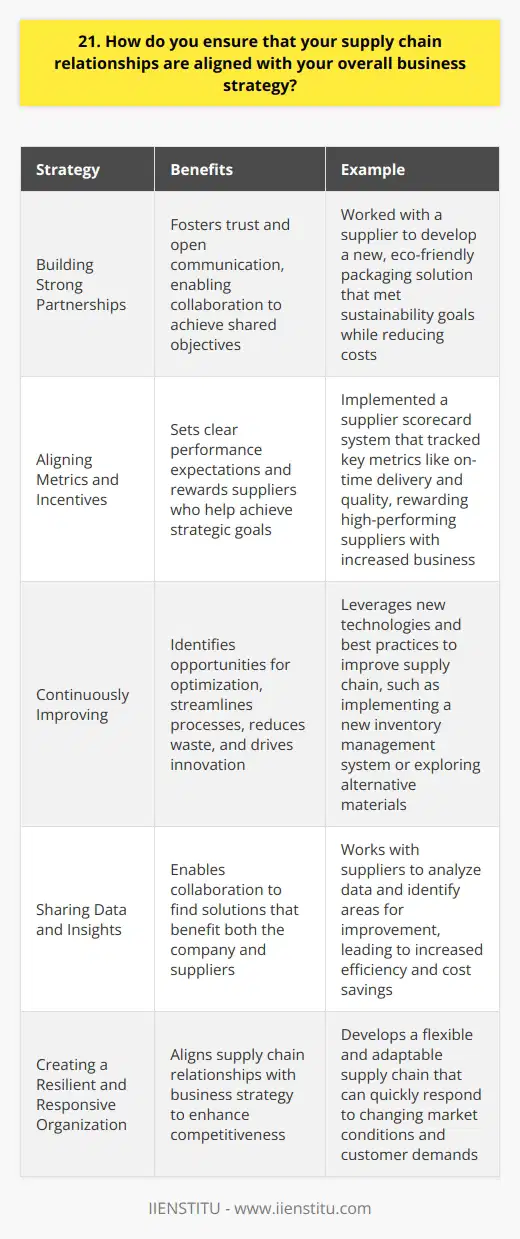
22. What are the key factors that contribute to building long-term, mutually beneficial supply chain partnerships?
Building long-term, mutually beneficial supply chain partnerships requires a focus on several key factors. In my experience, clear communication and transparency are essential for fostering trust between partners. When I worked at Acme Inc., we made sure to keep our suppliers informed about our needs and expectations.
Align Goals and Objectives
Partners should have a shared vision and align their goals. This creates a sense of unity and purpose. I believe that when everyone is working towards the same objectives, it's easier to overcome challenges and achieve success together.
Foster Collaboration and Innovation
Encourage collaboration and innovation among supply chain partners. Brainstorm ideas, share best practices, and work together to find creative solutions. Some of the most successful partnerships I've seen are those where both parties are willing to think outside the box.
Prioritize Quality and Reliability
Consistency is crucial in supply chain relationships. Partners must deliver high-quality products or services on time, every time. In my opinion, reliability is the foundation of any long-lasting partnership.
Invest in Technology and Data Sharing
Leverage technology to streamline processes and share data seamlessly. This improves efficiency and enables better decision-making. I've found that investing in the right tools can make a significant difference in the success of a partnership.
Cultivate a Win-Win Mindset
Approach the partnership with a win-win mindset. Look for ways to create value for both parties involved. When everyone benefits, there's a greater incentive to maintain and grow the relationship over time.
Building strong supply chain partnerships takes effort and commitment from all parties involved. By focusing on these key factors, companies can create lasting relationships that drive success and growth.
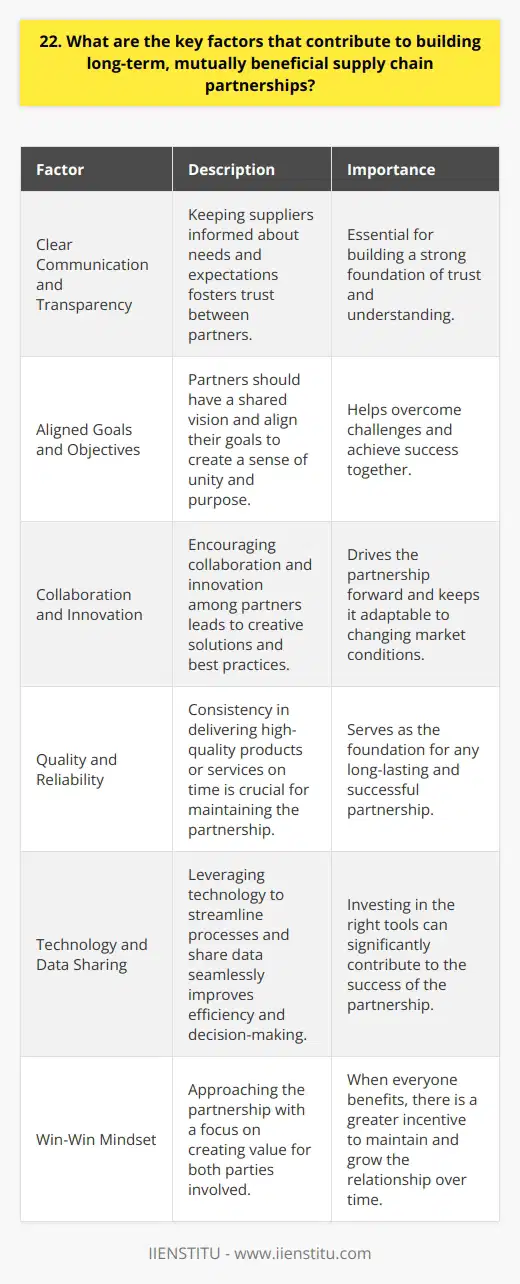
23. How do you manage the complexities of multi-tier supply chain relationships?
Managing the complexities of multi-tier supply chain relationships is a crucial skill in today's business environment. I believe that effective communication, collaboration, and strategic planning are key to navigating these intricacies.
Foster Open Communication
I prioritize regular and transparent communication with all stakeholders in the supply chain. This includes suppliers, manufacturers, distributors, and customers. By maintaining open lines of dialogue, I can quickly identify potential issues and work collaboratively to find solutions.
In my previous role, I implemented a quarterly supplier summit where we discussed market trends, shared best practices, and brainstormed ideas for process improvements. These face-to-face interactions strengthened our relationships and led to a 15% reduction in lead times.
Leverage Technology
I'm a firm believer in leveraging technology to streamline supply chain processes and enhance visibility. I've worked with various supply chain management software, such as SAP and Oracle, to optimize inventory levels, track shipments, and monitor performance metrics.
By utilizing real-time data analytics, I can make informed decisions and respond proactively to changing market conditions. For example, when faced with a sudden spike in demand for a particular product, I used predictive analytics to forecast future demand and adjust our production schedule accordingly. This helped us avoid stockouts and maintain a 98% service level.
Develop Contingency Plans
In the fast-paced world of supply chain management, disruptions are inevitable. That's why I always develop contingency plans to mitigate potential risks. By identifying critical suppliers, establishing backup sources, and creating flexible production capabilities, I can ensure business continuity even in the face of unexpected challenges.
During the COVID-19 pandemic, our primary supplier of raw materials was forced to shut down temporarily. Thanks to our contingency planning, we were able to quickly switch to an alternate supplier and minimize the impact on our production schedule.
In summary, managing multi-tier supply chain relationships requires a proactive, collaborative, and data-driven approach. By fostering open communication, leveraging technology, and developing contingency plans, I can effectively navigate the complexities and deliver results.
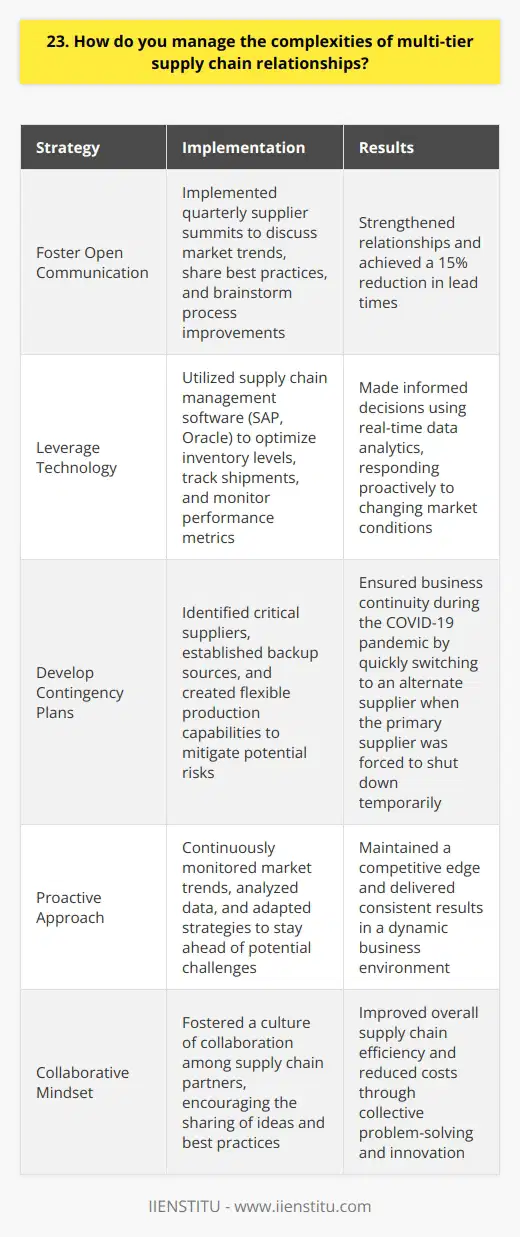
24. What strategies do you use to mitigate the impact of supplier or customer turnover on your supply chain?
I employ several strategies to minimize the impact of supplier or customer turnover on the supply chain:
Diversifying Supplier Base
I maintain relationships with multiple suppliers for critical components. This reduces dependency on any single supplier.
By sourcing from different geographic regions, I mitigate risks from localized disruptions like natural disasters or geopolitical events.
Effective Communication and Collaboration
I prioritize clear, frequent communication with suppliers and customers. This helps identify potential issues early.
Collaborating closely with partners allows me to develop contingency plans and adapt quickly when challenges arise.
Proactively Managing Relationships
I invest time in understanding suppliers' and customers' needs, goals, and pain points. Strong relationships increase loyalty and stability.
If a valued partner faces difficulties, I explore ways to provide support or flexibility to help them through it.
Monitoring and Risk Assessment
I continuously monitor key suppliers' financial health, performance metrics, and market conditions to anticipate potential disruptions.
When red flags appear, I proactively engage with the supplier to assess the situation and develop mitigation plans.
Leveraging Technology and Data
I utilize supply chain management software to increase visibility across the network. This enables faster response times.
Analyzing historical data helps me identify patterns and risk factors to inform strategic sourcing and inventory management decisions.
While some turnover is inevitable, these strategies help me build a more agile, resilient supply chain. My goal is always to minimize disruptions to deliver uninterrupted excellence for end customers.
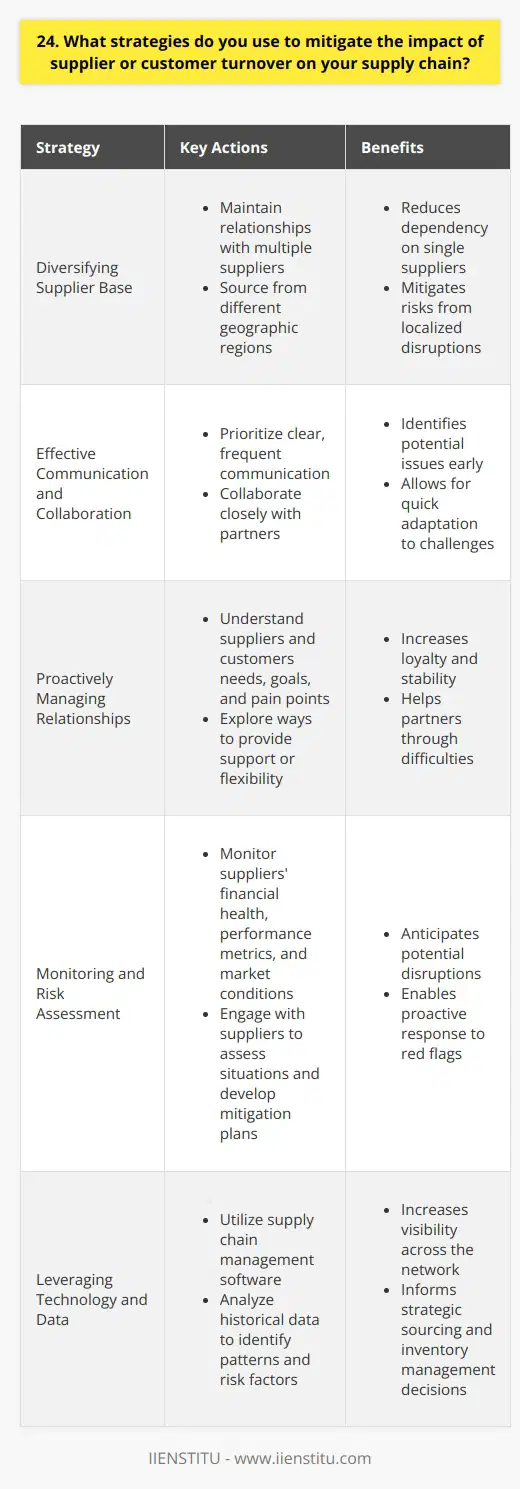
25. How do you foster a culture of transparency and accountability among supply chain partners?
Fostering a culture of transparency and accountability among supply chain partners is crucial for building trust and ensuring smooth operations. I believe that open communication is the foundation of transparency. I always encourage regular meetings and updates with partners to discuss goals, challenges, and progress. This keeps everyone on the same page and prevents misunderstandings.
Lead by Example
I also believe in leading by example. I make sure to be transparent about my own processes and decisions. This sets the tone for the entire supply chain and encourages others to do the same. When partners see that I'm being open and honest, they're more likely to reciprocate.
Establish Clear Metrics
Another key aspect of accountability is establishing clear metrics and expectations. I work with partners to define specific goals and KPIs. This provides a framework for measuring success and holding each other accountable. When everyone knows what's expected of them, it's easier to identify areas for improvement.
Encourage Feedback
I also make a point to encourage feedback from partners. I want to know what's working well and what needs attention. This feedback loop helps us continuously improve and strengthen our relationships. It also shows partners that their input is valued and that we're all in this together.
Celebrate Successes
Finally, I believe in celebrating successes along the way. When we hit milestones or overcome challenges, I make sure to acknowledge the contributions of our partners. This positive reinforcement encourages continued transparency and accountability. It reminds us that we're all working towards the same goals.
In my experience, fostering a culture of transparency and accountability takes consistent effort and leadership. But the payoff is worth it. When supply chain partners trust each other and operate with integrity, the entire system runs more smoothly. And that's good for everyone involved.

26. What are the most effective ways to manage intellectual property and confidentiality in supply chain relationships?
As a supply chain professional, I've found that effective intellectual property (IP) and confidentiality management is crucial. Here are some strategies I recommend based on my experience:
Establish Clear Agreements
Before entering into any supply chain relationship, it's essential to have well-defined contracts and non-disclosure agreements (NDAs). These legal documents should specify the scope of confidential information and the consequences of breaching confidentiality.
Implement Access Controls
Restrict access to sensitive information on a need-to-know basis. Use secure systems with role-based permissions. Regularly review and update access privileges.
Provide Employee Training
Educate your team about the importance of IP protection and confidentiality. Conduct regular training sessions to reinforce best practices. Encourage a culture of security awareness.
Monitor and Audit
Implement monitoring systems to detect any unauthorized access or data leaks. Conduct periodic audits to ensure compliance with confidentiality agreements. Promptly address any breaches or vulnerabilities.
Secure Communication Channels
Use encrypted communication methods when sharing sensitive information with supply chain partners. Avoid unsecured email or messaging platforms. Opt for secure file-sharing solutions.
Foster Trust and Transparency
Build strong relationships with your supply chain partners based on trust and transparency. Openly communicate expectations and concerns regarding IP and confidentiality. Work together to develop mutually beneficial strategies.
Remember, protecting intellectual property and maintaining confidentiality is a shared responsibility. By implementing these measures and staying vigilant, you can safeguard your company's valuable assets and foster successful supply chain partnerships.
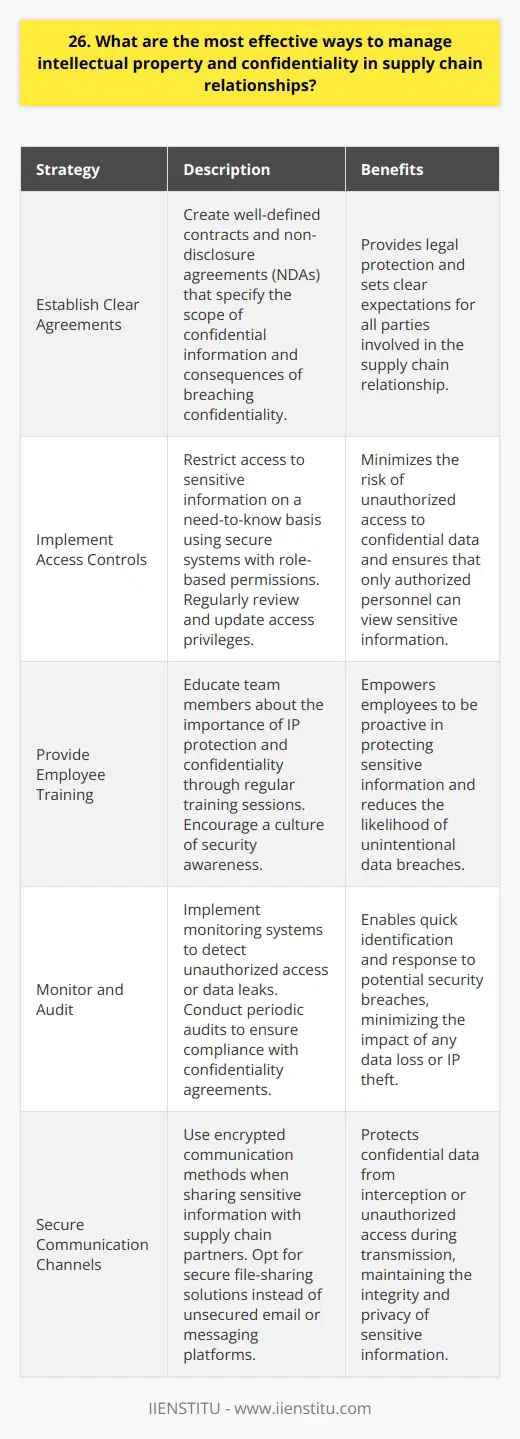
27. How do you ensure that your supply chain relationships are agile and responsive to changing market conditions?
I ensure that my supply chain relationships are agile and responsive to changing market conditions through several key strategies:
Building Strong Partnerships
I invest time in developing close, collaborative relationships with my suppliers. We openly share information and align our goals. By fostering trust and mutual understanding, we can quickly adapt to new challenges and opportunities together.
Prioritizing Communication
Regular, transparent communication is essential. I stay in frequent contact with my supply chain partners via multiple channels. We discuss market trends, customer needs, and any potential risks or disruptions on the horizon. Keeping everyone informed helps us stay nimble.
Leveraging Technology
I take advantage of supply chain management software, real-time data analytics, and other digital tools. These give me visibility across the entire supply network. With up-to-date insights, I can monitor performance, predict issues, and make fast decisions to optimize operations.
Emphasizing Flexibility in Contracts
When negotiating supplier contracts, I prioritize flexibility. I aim for agreements that allow room for adjustments as circumstances change. This could mean variable order quantities, alternative supply sources, or the ability to quickly ramp production up or down. Rigid contracts can hinder agility.
Continuously Improving and Innovating
I embrace a culture of continuous improvement within my supply chain. My team regularly reviews processes, identifies inefficiencies, and brainstorms innovative solutions. We stay open to new ideas, technologies, and best practices. By constantly enhancing our supply chain, we become more responsive over time.
Ultimately, an agile supply chain requires a proactive, collaborative approach. It's about anticipating change and positioning ourselves to adapt quickly. Through strong partnerships, real-time insights, flexibility, and a commitment to innovation, I work to build supply chains that thrive in dynamic markets.
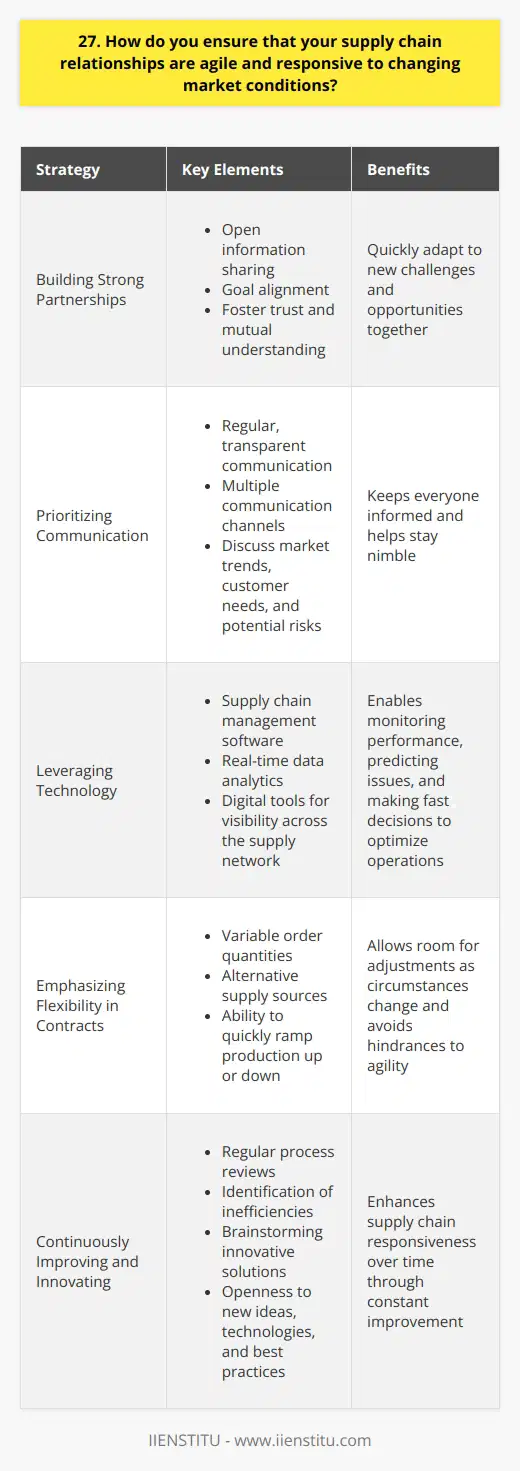
28. What role does trust play in maintaining and strengthening supply chain relationships?
Trust is the foundation of any successful supply chain relationship. When trust exists between partners, communication flows freely and transparently. This openness allows for the quick resolution of problems and the sharing of ideas to improve processes.
Building Trust Takes Time and Effort
Establishing trust doesn't happen overnight. It requires a consistent track record of following through on commitments. I remember one supplier who always delivered our orders on time, even when faced with unexpected challenges. Their reliability made me confident I could count on them during crunch times.
The Ripple Effects of a Breach in Trust
On the flip side, I've experienced how one breach of trust can unravel a partnership. We had a vendor who kept promising delivery dates they couldn't meet. After several letdowns, I lost faith and started looking for more dependable alternatives.
Trust Enables Collaboration and Innovation
When you have confidence in your supply chain, you're more willing to pursue ambitious joint projects. I worked closely with a trusted logistics provider to completely reengineer our distribution network. The process had its challenges, but our mutual trust kept the initiative moving forward.
Strengthening Bonds in Difficult Times
Tough situations are when trust really gets put to the test. During the pandemic, many of my suppliers faced disruptions. The ones who were upfront about the issues and proposed creative solutions ended up strengthening my trust in them.
At the end of the day, supply chains depend on people. And solid, trusting relationships between those people can make all the difference in overcoming obstacles and seizing opportunities together.
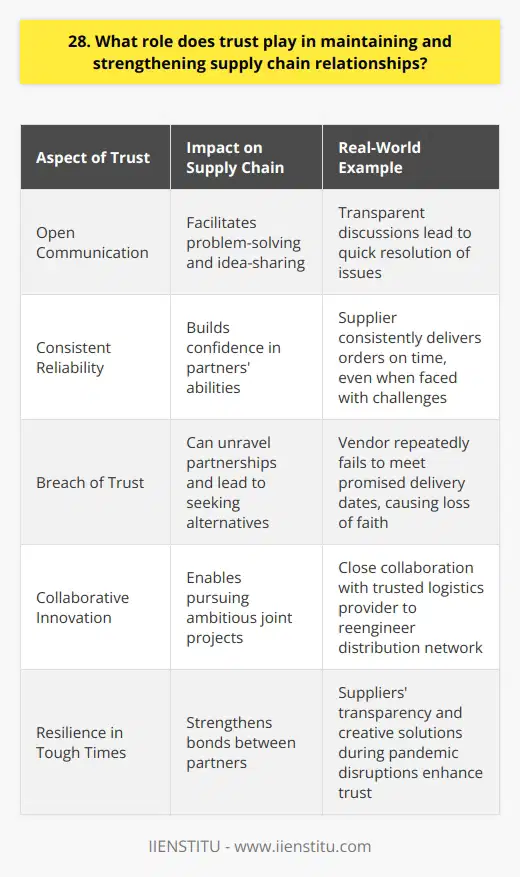
29. How do you balance the need for standardization with the desire for customization in supply chain partnerships?
In today's fast-paced business environment, finding the right balance between standardization and customization is crucial. I believe that effective supply chain partnerships require a mix of both approaches.
The Benefits of Standardization
Standardizing processes and procedures can help streamline operations and reduce costs. It ensures consistency across the supply chain, making it easier to manage and monitor performance. By establishing clear guidelines and best practices, partners can work together more efficiently and avoid misunderstandings.
Real-Life Example
In my previous role, we implemented a standardized ordering system with our suppliers. It simplified the process and reduced errors, saving us time and money. The suppliers appreciated the clarity and predictability it provided.
The Need for Customization
However, I also recognize that every partnership is unique and may require customized solutions. Adapting to specific needs and preferences can foster stronger relationships and drive innovation. By being flexible and open to customization, we can create value and differentiate ourselves from competitors.
Personal Experience
I once worked with a client who had very specific packaging requirements. By taking the time to understand their needs and developing a customized solution, we were able to exceed their expectations and win their long-term business. It taught me the importance of listening to partners and being willing to tailor our approach.
Finding the Right Balance
Ultimately, the key is to strike a balance between standardization and customization. By establishing a strong foundation of standardized processes, we can create efficiencies and ensure consistency. At the same time, we must be willing to adapt and customize when necessary to meet the unique needs of our partners.
I believe that open communication, flexibility, and a commitment to continuous improvement are essential for finding this balance. By working closely with our partners and being responsive to their needs, we can build strong, mutually beneficial relationships that drive success for all involved.
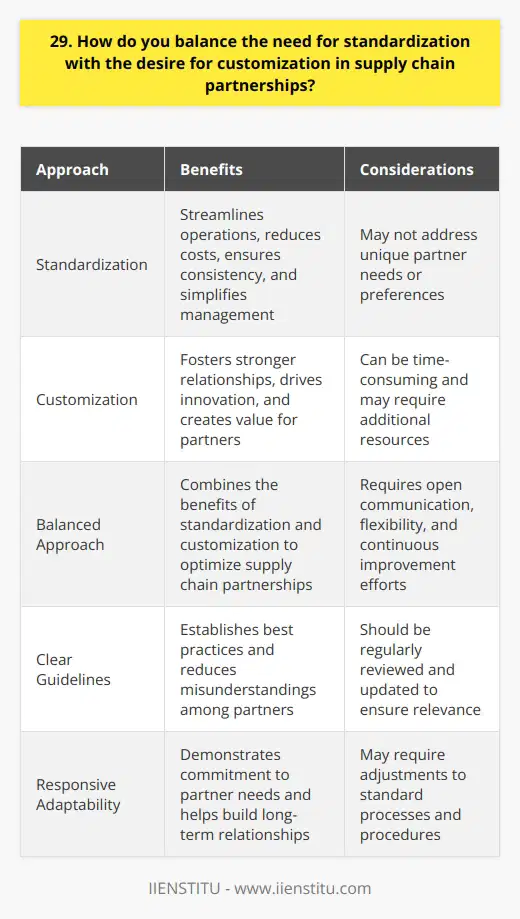
30. What are the key lessons you have learned about managing relationships in dynamic supply chains?
Throughout my career in supply chain management, I've learned that relationships are the foundation of success. Clear, honest communication is essential for building trust with suppliers, customers, and internal teams. I make it a priority to listen actively and address concerns promptly.
Collaboration is Key
In dynamic supply chains, collaboration is crucial. I've found that fostering a spirit of teamwork, both internally and with external partners, leads to better problem-solving and innovation. By working together, we can identify potential issues early and develop creative solutions.
Adaptability and Flexibility
Supply chains are constantly evolving, so adaptability is a must. I've learned to be flexible in my approach, ready to adjust strategies as needed. Whether it's responding to unexpected disruptions or seizing new opportunities, being agile has helped me navigate complex situations effectively.
Proactive Risk Management
Proactively managing risk is another key lesson. By continuously monitoring the supply chain, identifying potential risks, and developing contingency plans, I've been able to mitigate disruptions. Building strong relationships with multiple suppliers has also proven valuable in ensuring continuity during challenging times.
At the end of the day, managing relationships in dynamic supply chains requires a combination of interpersonal skills, strategic thinking, and a willingness to adapt. By prioritizing communication, collaboration, and proactive risk management, I've been able to build resilient, high-performing supply chains that deliver value to all stakeholders.
